Paul van Yperen's Blog, page 357
January 22, 2016
Sheila Sim (1922-2016)
On 19 January, British actress Sheila Sim (1922-2016) passed away, aged 93. She was the wife of the actor and director Richard Attenborough. As an actress she was mainly active in the 1940s and 1950s. She appeared in the Powell and Pressburger film, A Canterbury Tale (1944) and in 1952 she co-starred with her husband in the original cast of The Mousetrap by Agatha Christie, now the longest-running play ever.

British postcard in the Picturegoer Series, London, no. W. 582. Photo: Boulton Bros.
Land Girl
Sheila Beryl Grant Sim was born in Liverpool, Lancashire, in 1922 and later educated at Croydon high school. She started work in a bank, but soon came to the conclusion that the routine was not for her. Instead she spent two years training as an actor at Royal Academy of Dramatic Art (RADA) in London, where she met her future husband, Richard Attenborough .
Her first stage appearance, in 1942, was at the Intimate theatre, Palmers Green, in Ivor Novello ’s Fresh Fields. She remained with the theatre’s repertory company for six months, then went to the small but fashionable Q theatre at the end of Kew Bridge for another six months, after which she toured with Noël Coward’s This Happy Breed and the drama Landslide. She was in Landslide at the Westminster theatre in London in 1943, and played the lead in the domestic comedy To Dorothy a Son.
Sim made her film debut in Michael Powell and Emeric Pressburger’s memorable A Canterbury Tale (1944), a modern propaganda adaptation of the Chaucer story, in which a treacherous wartime magistrate is brought to book by a land girl, a British army sergeant and an American serviceman. She drew on her own experience for the role of the land girl, having volunteered in 1940 to work for the Women’s Land Army at harvest time, when she was posted to a farm near Hereford.
The following year Sim played a leading role in an RKO film, Great Day (Lance Comfort, 1945), starring Eric Portman and Flora Robson. The story is about a village thrown into turmoil by an impending visit from Eleanor Roosevelt. Sim also had a part in Journey Together, a wartime training drama made by the RAF Film Unit. Attenborough was also in the cast, and they were married at the start of the year.
Sim made her television debut in 1946 in a series of plays, and was also in demand for radio work. She appeared in the film The Guinea Pig/The Outsider (Roy Boulting, 1948), in which Attenborough played a working-class boy at a private school, and she was signed up by J. Arthur Rank, then the major if not always the most imaginative of British film producers. Sim and Attenborough also worked together in Dancing With Crime (John Paddy Carstairs, 1947) and The Magic Box (John Boulting, 1951) with Robert Donat . She had a prominent part in the fantasy Pandora and the Flying Dutchman (Albert Lewin, 1951), starring Ava Gardner as a nightclub singer and James Mason as a drifter in a Spanish fishing village.
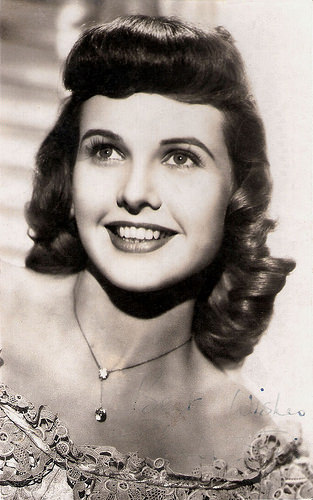
British autograph card.
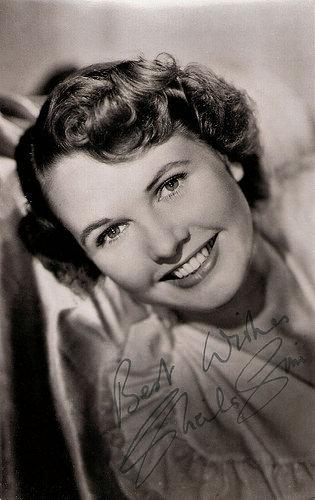
British autograph card.
The world’s longest initial run of a play
When Agatha Christie’s murder mystery play The Mousetrap opened in London in 1952, Sheila Sim had doubts about its ability to last for six months, describes Dennis Barker in The Guardian . "But the fact that she could wait until just before its 50th anniversary before publicly confessing those doubts, at a lunch at the Savoy hotel with 300 other actors who had appeared in the play, showed them to be unfounded.
By then it had long passed its 20,000th performance, and it is still going strong, as the world’s longest initial run of a play. Through starring as Mollie Ralston, owner of the snowed-in Monkswell Manor, Sim set the seal on her growing reputation as an actor. Her husband, Richard Attenborough , co-starred in the play as Detective Sergeant Trotter, who arrives on a pair of skis, and the couple took a 10% profit share. This continued to serve them very well, Attenborough eventually selling it only when trying to keep the production of his 1982 film Gandhi afloat."
In the cinema she starred in the adventure film West of Zanzibar (Harry Watt, 1954) with Anthony Steel , and Sim’s final film credit was The Night My Number Came Up (Leslie Norman, 1955) with Michael Redgrave .
She retired to look after her three children. From 1956, the family lived comfortably in Richmond upon Thames, south-west London. In 1968, Sim was sworn in as a magistrate in Surbiton, joining the Richmond bench. She was also an enthusiastic member of the Richmond Society, the amenity group that contributed to the thinking behind the restoration and redevelopment of the banks of the Thames at Richmond.
In 2004, her daughter Jane and granddaughter Lucy were killed by the Indian Ocean tsunami while on holiday in Thailand. In 2012, it was announced that Sim had been diagnosed with senile dementia. Richard Attenborough died in 2014. Sim and Attenborough had been married for nearly 70 years.
Sheila Sim’s death was announced on 19 January 2016. She is survived by her children Michael Attenborough, a director, and Charlotte Attenborough, who works as an actress.
Extrait A Canterbury Tale (1944). Source: Joel Spiggott (YouTube).
Trailer Dancing With Crime (1947). Source: Cohen Film Collection (YouTube).
Sources: Dennis Barker (The Guardian), Wikipedia, and .

British postcard in the Picturegoer Series, London, no. W. 582. Photo: Boulton Bros.
Land Girl
Sheila Beryl Grant Sim was born in Liverpool, Lancashire, in 1922 and later educated at Croydon high school. She started work in a bank, but soon came to the conclusion that the routine was not for her. Instead she spent two years training as an actor at Royal Academy of Dramatic Art (RADA) in London, where she met her future husband, Richard Attenborough .
Her first stage appearance, in 1942, was at the Intimate theatre, Palmers Green, in Ivor Novello ’s Fresh Fields. She remained with the theatre’s repertory company for six months, then went to the small but fashionable Q theatre at the end of Kew Bridge for another six months, after which she toured with Noël Coward’s This Happy Breed and the drama Landslide. She was in Landslide at the Westminster theatre in London in 1943, and played the lead in the domestic comedy To Dorothy a Son.
Sim made her film debut in Michael Powell and Emeric Pressburger’s memorable A Canterbury Tale (1944), a modern propaganda adaptation of the Chaucer story, in which a treacherous wartime magistrate is brought to book by a land girl, a British army sergeant and an American serviceman. She drew on her own experience for the role of the land girl, having volunteered in 1940 to work for the Women’s Land Army at harvest time, when she was posted to a farm near Hereford.
The following year Sim played a leading role in an RKO film, Great Day (Lance Comfort, 1945), starring Eric Portman and Flora Robson. The story is about a village thrown into turmoil by an impending visit from Eleanor Roosevelt. Sim also had a part in Journey Together, a wartime training drama made by the RAF Film Unit. Attenborough was also in the cast, and they were married at the start of the year.
Sim made her television debut in 1946 in a series of plays, and was also in demand for radio work. She appeared in the film The Guinea Pig/The Outsider (Roy Boulting, 1948), in which Attenborough played a working-class boy at a private school, and she was signed up by J. Arthur Rank, then the major if not always the most imaginative of British film producers. Sim and Attenborough also worked together in Dancing With Crime (John Paddy Carstairs, 1947) and The Magic Box (John Boulting, 1951) with Robert Donat . She had a prominent part in the fantasy Pandora and the Flying Dutchman (Albert Lewin, 1951), starring Ava Gardner as a nightclub singer and James Mason as a drifter in a Spanish fishing village.

British autograph card.

British autograph card.
The world’s longest initial run of a play
When Agatha Christie’s murder mystery play The Mousetrap opened in London in 1952, Sheila Sim had doubts about its ability to last for six months, describes Dennis Barker in The Guardian . "But the fact that she could wait until just before its 50th anniversary before publicly confessing those doubts, at a lunch at the Savoy hotel with 300 other actors who had appeared in the play, showed them to be unfounded.
By then it had long passed its 20,000th performance, and it is still going strong, as the world’s longest initial run of a play. Through starring as Mollie Ralston, owner of the snowed-in Monkswell Manor, Sim set the seal on her growing reputation as an actor. Her husband, Richard Attenborough , co-starred in the play as Detective Sergeant Trotter, who arrives on a pair of skis, and the couple took a 10% profit share. This continued to serve them very well, Attenborough eventually selling it only when trying to keep the production of his 1982 film Gandhi afloat."
In the cinema she starred in the adventure film West of Zanzibar (Harry Watt, 1954) with Anthony Steel , and Sim’s final film credit was The Night My Number Came Up (Leslie Norman, 1955) with Michael Redgrave .
She retired to look after her three children. From 1956, the family lived comfortably in Richmond upon Thames, south-west London. In 1968, Sim was sworn in as a magistrate in Surbiton, joining the Richmond bench. She was also an enthusiastic member of the Richmond Society, the amenity group that contributed to the thinking behind the restoration and redevelopment of the banks of the Thames at Richmond.
In 2004, her daughter Jane and granddaughter Lucy were killed by the Indian Ocean tsunami while on holiday in Thailand. In 2012, it was announced that Sim had been diagnosed with senile dementia. Richard Attenborough died in 2014. Sim and Attenborough had been married for nearly 70 years.
Sheila Sim’s death was announced on 19 January 2016. She is survived by her children Michael Attenborough, a director, and Charlotte Attenborough, who works as an actress.
Extrait A Canterbury Tale (1944). Source: Joel Spiggott (YouTube).
Trailer Dancing With Crime (1947). Source: Cohen Film Collection (YouTube).
Sources: Dennis Barker (The Guardian), Wikipedia, and .
Published on January 22, 2016 22:00
January 21, 2016
EFSP's Dazzling Dozen: Star Pin-ups - Cheesecake
I love vintage star pin-ups. You love star pin-ups too, don't you? Why do we all love star pin-ups? These lovely bathing beauties, those sensual love goddesses from the golden age of Hollywood, sex kitten Brigitte Bardot in a corset... I guess it's not only their beauty but also the fun they have ánd give. Here are 12 vintage star pin-up postcards to make you smile.
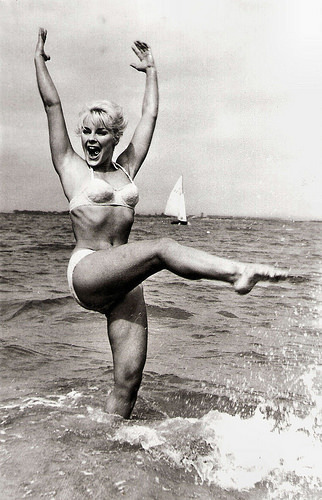
Romanian postcard by Casa Filmului Acin, no. 502.
In the late 1950s blonde, German Elke Sommer (1940) was a European sex symbol before conquering Hollywood in the early 1960s. With her trademark pouty lips, high cheek bones and sky-high bouffant hair-dos, Sommer made 99 film and television appearances between 1959 and 2005. The gorgeous film star was also one of the most popular pin-up girls of the sixties, and posed twice for Playboy magazine.
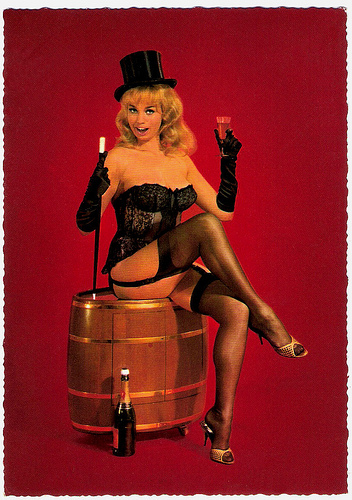
German Postcard by Krüger, no. 900/272.
Film and TV actress Barbara Valentin (1940-2002) was dubbed the 'German Jayne Mansfield' and a 'Scandal Magnet'. Her résumé includes sexploitation but also art films directed by Rainer Werner Fassbinder. Her private life was fodder for the tabloids. Pop star Freddie Mercury was ‘the love of her life’.
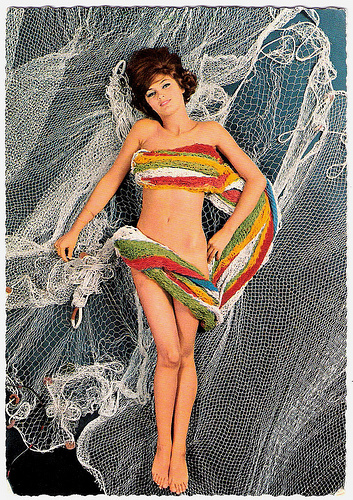
German postcard by Krüger, no. 902/391. Photo: Gérard Decaux.
Beautiful Claudia Lebail was a French starlet and Playboy model of the 1960s.
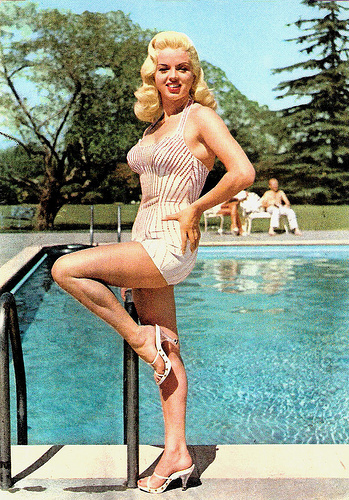
Italian postcard by Rotalcolor, no. 18.
Blonde and curvey Diana Dors (1931-1984) was called ‘The English Marilyn Monroe’, to her disgust. In her own words: “I was the first home-grown sex symbol, rather like Britain's naughty seaside postcards."
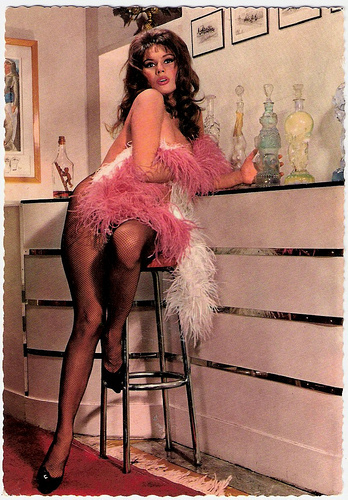
German postcard by Krüger, no. 902/334. Photo: Art Messick.
Exotic starlet Maria-Rosa Rodriguez was the sexy leading lady of a dozen French and Italian films of the 1960s and early 1970s. Her main claim to fame was the Louis de Funès comedy Le grand restaurant (1966).
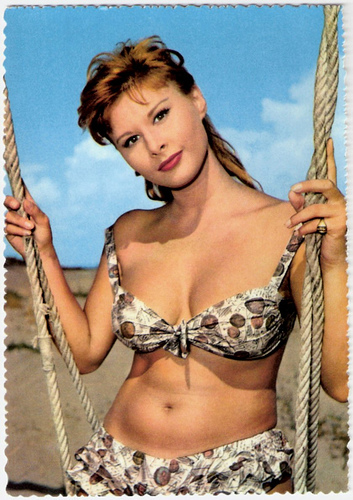
Italian postcard by Rotalfoto, no. 1.
Italian actress Marisa Allasio was a glamorous starlet who appeared in nearly twenty pictures in the 1950s. She was nicknamed ‘The Italian Jayne Mansfield’. In 1958 her career stopped abruptly when she married and became a countess.
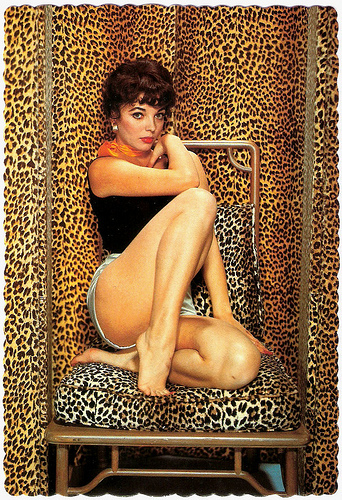
Canadian postcard in the Fan Club Postcard Series, no. 2.
Glamorous English actress Joan Collins (1933) is one of the great survivors of the cinema. She began in the early 1950s as a starlet of the British film. 20th Century Fox brought her to Hollywood as their answer to Elizabeth Taylor.
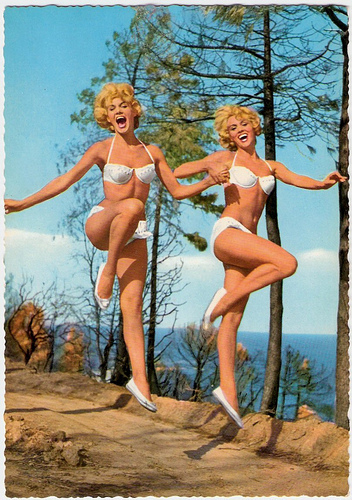
German postcard by Krüger, no. 902/199. Photo: Gérard Decaux.
Alice & Ellen Kessler (1936) were popular in Europe, especially in Germany and Italy, in the 1950s and 1960s, as a singing, dancing and acting twin. The German sisters are usually credited as the Kessler Twins or Die Kessler-Zwillinge.
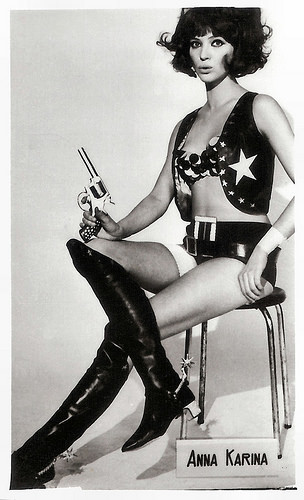
Small Romanian collectors card by Cooperativa Fotografia, no. 10.
Film actress, singer and writer Anna Karina (1940) is an icon of the Nouvelle Vague.
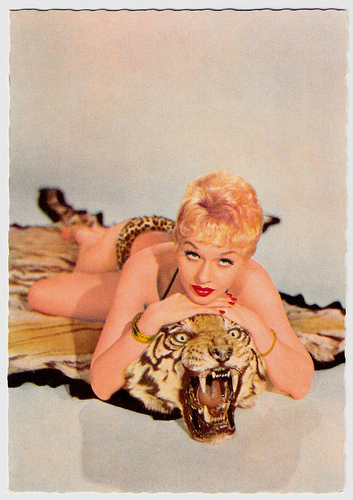
German postcard by ISV, no. 11/6.
Beautiful starlet Vanda Hudson (1937-2004) was one of the blond bombshells of the British cinema. She appeared in a dozen films and TV series of the late 1950s and early 1960s.
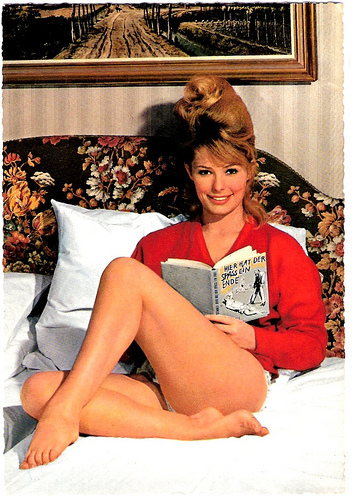
German postcard by Krüger, no. 902/309. Photo: Bernard of Hollywood.
Danish singer, actress and icon Vivi Bach (1939-2013) was nicknamed ‘the first Danish teenager of Denmark' and 'the Danish Brigitte Bardot’. Although not a very talented actress she appeared in 48 films between 1958 and 1974.
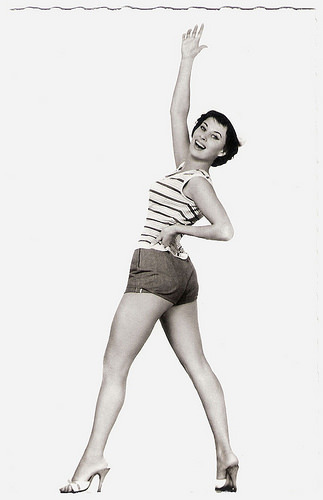
French postcard by Editions du Globe, Paris, no. 866. Photo: Sam Lévin.
Turkish-French actress and singer Magali Noël acted in French and Italian films between 1951 and 2002. The sexy actress was an object of desire in three masterpieces of Federico Fellini.
Next friday we follow up this Cheesecake post with a Beefcake post.
This is a post for Postcard Friendship Friday, hosted by Beth at the The Best Hearts are Crunchy. You can visit her by clicking on the button below.


Romanian postcard by Casa Filmului Acin, no. 502.
In the late 1950s blonde, German Elke Sommer (1940) was a European sex symbol before conquering Hollywood in the early 1960s. With her trademark pouty lips, high cheek bones and sky-high bouffant hair-dos, Sommer made 99 film and television appearances between 1959 and 2005. The gorgeous film star was also one of the most popular pin-up girls of the sixties, and posed twice for Playboy magazine.

German Postcard by Krüger, no. 900/272.
Film and TV actress Barbara Valentin (1940-2002) was dubbed the 'German Jayne Mansfield' and a 'Scandal Magnet'. Her résumé includes sexploitation but also art films directed by Rainer Werner Fassbinder. Her private life was fodder for the tabloids. Pop star Freddie Mercury was ‘the love of her life’.

German postcard by Krüger, no. 902/391. Photo: Gérard Decaux.
Beautiful Claudia Lebail was a French starlet and Playboy model of the 1960s.

Italian postcard by Rotalcolor, no. 18.
Blonde and curvey Diana Dors (1931-1984) was called ‘The English Marilyn Monroe’, to her disgust. In her own words: “I was the first home-grown sex symbol, rather like Britain's naughty seaside postcards."

German postcard by Krüger, no. 902/334. Photo: Art Messick.
Exotic starlet Maria-Rosa Rodriguez was the sexy leading lady of a dozen French and Italian films of the 1960s and early 1970s. Her main claim to fame was the Louis de Funès comedy Le grand restaurant (1966).

Italian postcard by Rotalfoto, no. 1.
Italian actress Marisa Allasio was a glamorous starlet who appeared in nearly twenty pictures in the 1950s. She was nicknamed ‘The Italian Jayne Mansfield’. In 1958 her career stopped abruptly when she married and became a countess.

Canadian postcard in the Fan Club Postcard Series, no. 2.
Glamorous English actress Joan Collins (1933) is one of the great survivors of the cinema. She began in the early 1950s as a starlet of the British film. 20th Century Fox brought her to Hollywood as their answer to Elizabeth Taylor.

German postcard by Krüger, no. 902/199. Photo: Gérard Decaux.
Alice & Ellen Kessler (1936) were popular in Europe, especially in Germany and Italy, in the 1950s and 1960s, as a singing, dancing and acting twin. The German sisters are usually credited as the Kessler Twins or Die Kessler-Zwillinge.

Small Romanian collectors card by Cooperativa Fotografia, no. 10.
Film actress, singer and writer Anna Karina (1940) is an icon of the Nouvelle Vague.

German postcard by ISV, no. 11/6.
Beautiful starlet Vanda Hudson (1937-2004) was one of the blond bombshells of the British cinema. She appeared in a dozen films and TV series of the late 1950s and early 1960s.

German postcard by Krüger, no. 902/309. Photo: Bernard of Hollywood.
Danish singer, actress and icon Vivi Bach (1939-2013) was nicknamed ‘the first Danish teenager of Denmark' and 'the Danish Brigitte Bardot’. Although not a very talented actress she appeared in 48 films between 1958 and 1974.

French postcard by Editions du Globe, Paris, no. 866. Photo: Sam Lévin.
Turkish-French actress and singer Magali Noël acted in French and Italian films between 1951 and 2002. The sexy actress was an object of desire in three masterpieces of Federico Fellini.
Next friday we follow up this Cheesecake post with a Beefcake post.
This is a post for Postcard Friendship Friday, hosted by Beth at the The Best Hearts are Crunchy. You can visit her by clicking on the button below.

Published on January 21, 2016 22:00
January 20, 2016
Nicoletta Braschi
Italian actress Nicoletta Braschi (1960) is best known for the acclaimed film La vita è bella (1997), in which she co-starred with her husband Roberto Benigni.
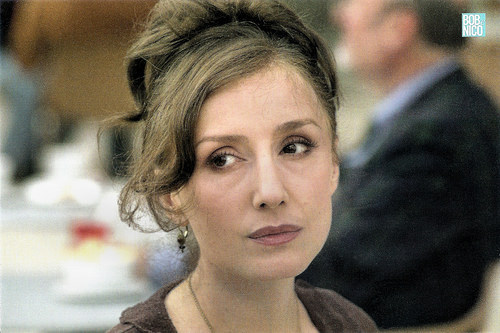
Italian postcard by Cineteca Bologna. Photo: Claudio Iannone. Publicity still for La tigre e la neve/The Tiger and the Snow (Roberto Benigni, 2005).
The Little Devil
Nicoletta Braschi was born on April 19, 1960 in Cesena, Emilia-Romagna, Italy. Braschi studied in Rome's Academy of Dramatic Arts where she first met Roberto Benigni in 1980.
Her film debut was the anthology comedy Tu Mi Turbi/You Upset Me (Roberto Benigni, 1983) in which she played the Virgin Mary. It was also the directorial debut of Benigni and the first film in which they co-starred.
Next she appeared in the American film Down by Law (Jim Jarmusch, 1986). The film centres on the arrest, incarceration, and escape from jail of three men (Tom Waits, John Lurie and Roberto Benigni ). The trio eventually chance across a house in the forest, the residence of Nicoletta (Braschi). Bob (Benigni) and Nicoletta instantly fall in love, and Bob decides to stay with her in the forest.
She also appeared in Benigni’s comedy Il piccolo diavolo/The Little Devil (Roberto Benigni, 1988). Benigni stars as a little devil Giuditta who follows Father Maurice (Walther Matthau) and often gets him into trouble. Braschi plays another little devil who manages to attract Giuditta who finally leaves Maurice and follows her ‘elsewhere’.
She again worked with Jim Jarmusch on a segment of the American anthology film Mystery Train (Jim Jarmusch, 1989). She appeared in the segment A Ghost as an Italian widow stranded in Memphis, Tennessee overnight. Braschi also played a supporting part in the British-Italian drama The Sheltering Sky (Bernardo Bertolucci, 1990), based on the 1949 novel by Paul Bowles.
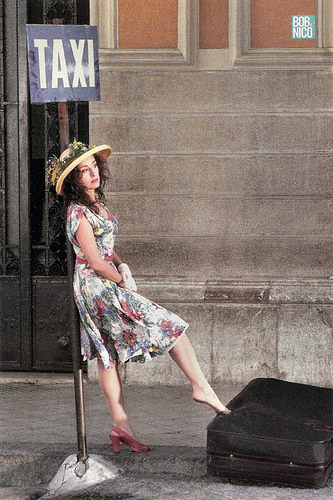
Italian postcard by Cineteca Bologna. Photo: Mario Tursi. Publicity still for Il piccolo diavolo/The Little Devil (Roberto Benigni, 1988).
The Monster
In 1991, Nicoletta Braschi married Roberto Benigni . With her husband she then starred in one of their most successful collaborations, the comedy Johnny Stecchino (Roberto Benigni, 1992). She played Maria, the girlfriend of Johnny Stecchino, an Italian mobster. She meets a quirky school bus driver for students with Down syndrome, who bears a striking resemblance to her husband who is wanted by Sicilian mobsters for treason and murder.
Maria plans to trick the mobsters to kill Dante thinking he is Stecchino. The film takes several unexpected twists when Maria begins to fall for Dante, and it becomes clear that Dante cannot possibly be the cold blooded killer Stecchino. During its release in 1991, it was the highest grossing film in Italy.
She had a small part in Son of the Pink Panther (Blake Edwards, 1993) is a continuation of the The Pink Panther film series. Roberto Benigni starred as Inspector Clouseau's illegitimate son. Also in this film are Panther regulars Herbert Lom , Burt Kwouk and Graham Stark and a star of the original 1963 film, Claudia Cardinale . However, Son of the Pink Panther failed to generate critical or commercial success, the loss of Peter Sellers as Clouseau proving once again to be too great.
A huge success in Europe was the Italian-French comedy Il mostro/The Monster (Roberto Benigni, 1994) starring Benigni as a man who is mistaken by police profilers for a serial killer due to a misunderstanding of the man's strange behaviour. Braschi played an attractive police officer, who goes undercover as his roommate. This film was, at the time it came out, the highest-grossing film in Italy.
In 1997 Nicoletta Braschi starred in the comedy Ovosodo/Boiled Egg (Paolo Virzi, 1997) as a depressed teacher encouraging a student to work and study harder. The film won her a David di Donatello award (Italy's equivalent of the Oscars) and much praise from critics and the public.

Italian postcard by Cineteca Bologna. Photo: Mario Tursi. Publicity still for Il piccolo diavolo/The Little Devil (Roberto Benigni, 1988).
Life is Beautiful
Nicoletta Braschi’s biggest success was La Vita è Bella/Life is Beautiful (Roberto Benigni, 1998). Braschi played the wife of an Italian Jew (Benigni) imprisoned in a concentration camp. Part of the film came from Benigni's own family history; before Roberto's birth, his father had survived three years of internment at the Bergen-Belsen concentration camp.
The film was a widely praised success that launched both Braschi and her husband into the international spotlight. Roberto Benigni won the Academy Award for Best Actor at the 71st Academy Awards as well as the Academy Award for Best Original Dramatic Score and the Academy Award for Best Foreign Language Film. Braschi was nominated for a Screen Actors Guild award as a cast member of that film. La Vita è Bella is the highest grossing film to be made in Italy, and the second highest grossing foreign film in the United States.
Braschi played the Blue Fairy in Pinocchio (Roberto Benigni, 2002), based on The Adventures of Pinocchio by Carlo Collodi with Benigni portraying Pinocchio. In the United States, Pinocchio was lambasted by critics, in particular for the English dub. The original Italian version was not so poorly greeted and received six nominations at the David di Donatello Awards, winning two, as well as winning one of the two awards it was nominated for at the Italian National Syndicate of Film Journalists.
In 2002, Braschi was a member of the jury at the Berlin Film Festival. In 2005 she starred in and produced La tigre e la neve/The Tiger and the Snow (Roberto Benigni, 2005), a love story set during the initial stage of the Iraq War. This was her last film till now.
In 2010 Nicoletta Braschi toured the Italian theatres starring in Tradimenti, based on Harold Pinter's play Betrayal.
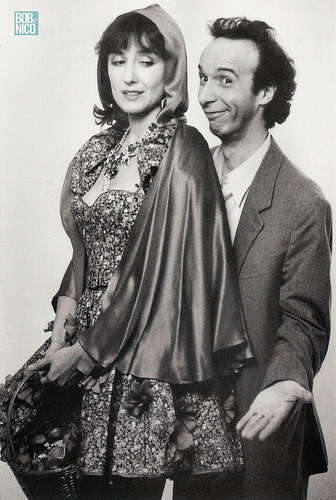
Italian postcard by Cineteca Bologna. Photo: Mimmo Cattarinich. Publicity still for Il Mostro/The Monster (Roberto Benigni, 1994).
Sources: Wikipedia and .

Italian postcard by Cineteca Bologna. Photo: Claudio Iannone. Publicity still for La tigre e la neve/The Tiger and the Snow (Roberto Benigni, 2005).
The Little Devil
Nicoletta Braschi was born on April 19, 1960 in Cesena, Emilia-Romagna, Italy. Braschi studied in Rome's Academy of Dramatic Arts where she first met Roberto Benigni in 1980.
Her film debut was the anthology comedy Tu Mi Turbi/You Upset Me (Roberto Benigni, 1983) in which she played the Virgin Mary. It was also the directorial debut of Benigni and the first film in which they co-starred.
Next she appeared in the American film Down by Law (Jim Jarmusch, 1986). The film centres on the arrest, incarceration, and escape from jail of three men (Tom Waits, John Lurie and Roberto Benigni ). The trio eventually chance across a house in the forest, the residence of Nicoletta (Braschi). Bob (Benigni) and Nicoletta instantly fall in love, and Bob decides to stay with her in the forest.
She also appeared in Benigni’s comedy Il piccolo diavolo/The Little Devil (Roberto Benigni, 1988). Benigni stars as a little devil Giuditta who follows Father Maurice (Walther Matthau) and often gets him into trouble. Braschi plays another little devil who manages to attract Giuditta who finally leaves Maurice and follows her ‘elsewhere’.
She again worked with Jim Jarmusch on a segment of the American anthology film Mystery Train (Jim Jarmusch, 1989). She appeared in the segment A Ghost as an Italian widow stranded in Memphis, Tennessee overnight. Braschi also played a supporting part in the British-Italian drama The Sheltering Sky (Bernardo Bertolucci, 1990), based on the 1949 novel by Paul Bowles.

Italian postcard by Cineteca Bologna. Photo: Mario Tursi. Publicity still for Il piccolo diavolo/The Little Devil (Roberto Benigni, 1988).
The Monster
In 1991, Nicoletta Braschi married Roberto Benigni . With her husband she then starred in one of their most successful collaborations, the comedy Johnny Stecchino (Roberto Benigni, 1992). She played Maria, the girlfriend of Johnny Stecchino, an Italian mobster. She meets a quirky school bus driver for students with Down syndrome, who bears a striking resemblance to her husband who is wanted by Sicilian mobsters for treason and murder.
Maria plans to trick the mobsters to kill Dante thinking he is Stecchino. The film takes several unexpected twists when Maria begins to fall for Dante, and it becomes clear that Dante cannot possibly be the cold blooded killer Stecchino. During its release in 1991, it was the highest grossing film in Italy.
She had a small part in Son of the Pink Panther (Blake Edwards, 1993) is a continuation of the The Pink Panther film series. Roberto Benigni starred as Inspector Clouseau's illegitimate son. Also in this film are Panther regulars Herbert Lom , Burt Kwouk and Graham Stark and a star of the original 1963 film, Claudia Cardinale . However, Son of the Pink Panther failed to generate critical or commercial success, the loss of Peter Sellers as Clouseau proving once again to be too great.
A huge success in Europe was the Italian-French comedy Il mostro/The Monster (Roberto Benigni, 1994) starring Benigni as a man who is mistaken by police profilers for a serial killer due to a misunderstanding of the man's strange behaviour. Braschi played an attractive police officer, who goes undercover as his roommate. This film was, at the time it came out, the highest-grossing film in Italy.
In 1997 Nicoletta Braschi starred in the comedy Ovosodo/Boiled Egg (Paolo Virzi, 1997) as a depressed teacher encouraging a student to work and study harder. The film won her a David di Donatello award (Italy's equivalent of the Oscars) and much praise from critics and the public.

Italian postcard by Cineteca Bologna. Photo: Mario Tursi. Publicity still for Il piccolo diavolo/The Little Devil (Roberto Benigni, 1988).
Life is Beautiful
Nicoletta Braschi’s biggest success was La Vita è Bella/Life is Beautiful (Roberto Benigni, 1998). Braschi played the wife of an Italian Jew (Benigni) imprisoned in a concentration camp. Part of the film came from Benigni's own family history; before Roberto's birth, his father had survived three years of internment at the Bergen-Belsen concentration camp.
The film was a widely praised success that launched both Braschi and her husband into the international spotlight. Roberto Benigni won the Academy Award for Best Actor at the 71st Academy Awards as well as the Academy Award for Best Original Dramatic Score and the Academy Award for Best Foreign Language Film. Braschi was nominated for a Screen Actors Guild award as a cast member of that film. La Vita è Bella is the highest grossing film to be made in Italy, and the second highest grossing foreign film in the United States.
Braschi played the Blue Fairy in Pinocchio (Roberto Benigni, 2002), based on The Adventures of Pinocchio by Carlo Collodi with Benigni portraying Pinocchio. In the United States, Pinocchio was lambasted by critics, in particular for the English dub. The original Italian version was not so poorly greeted and received six nominations at the David di Donatello Awards, winning two, as well as winning one of the two awards it was nominated for at the Italian National Syndicate of Film Journalists.
In 2002, Braschi was a member of the jury at the Berlin Film Festival. In 2005 she starred in and produced La tigre e la neve/The Tiger and the Snow (Roberto Benigni, 2005), a love story set during the initial stage of the Iraq War. This was her last film till now.
In 2010 Nicoletta Braschi toured the Italian theatres starring in Tradimenti, based on Harold Pinter's play Betrayal.

Italian postcard by Cineteca Bologna. Photo: Mimmo Cattarinich. Publicity still for Il Mostro/The Monster (Roberto Benigni, 1994).
Sources: Wikipedia and .
Published on January 20, 2016 22:00
January 19, 2016
Imported from the USA: Ramon Novarro
Mexican-American actor Ramon Novarro (1899-1968) was promoted as 'The Latin Lover' and became one of the top box office attractions of the 1920s and early 1930s. In 1925 he appeared in his most famous role, as the title character in Ben-Hur: A Tale of the Christ (Fred Niblo, 1925). He later co-starred with Norma Shearer in The Student Prince in Old Heidelberg (Ernst Lubitsch, 1927) and with Greta Garbo in Mata Hari (George Fitzmaurice, 1931). Novarro also worked in the European cinema. In 1968 he was murdered by two young hustlers.
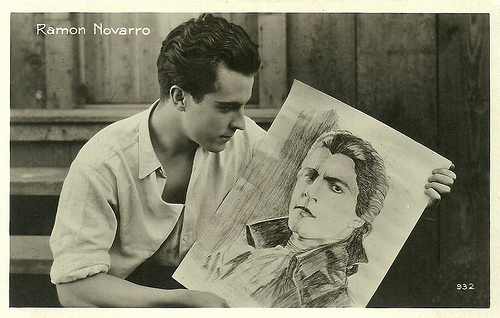
Italian postcard by Ed. Vettori, Bologna, no. 932. Ramon Novarro holding a sketch for the period piece Scaramouche (Rex Ingram, 1923), in which Novarro had the title role. The film, produced by Metro Pictures, was based on a novel by Rafael Sabatini, and co-starred Alice Terry and Lewis Stone.
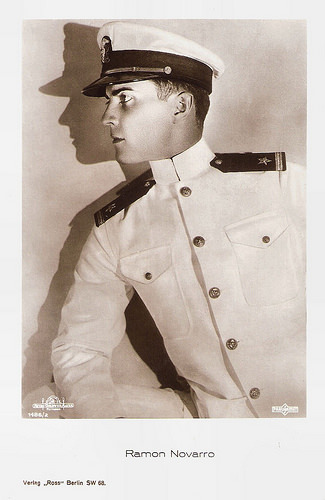
German postcard by Ross Verlag, no. 1486/2, 1927-1928. Photo: MGM / ParUfaMet.
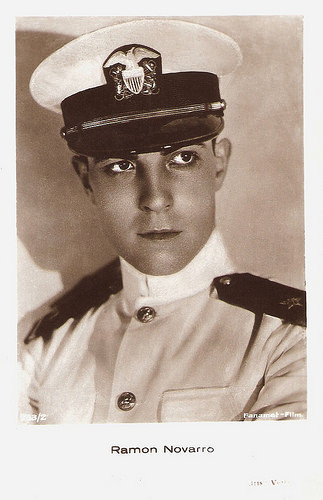
Austrian postcard by Iris-Verlag, no. 753/2. Photo: Fanamet-Film.
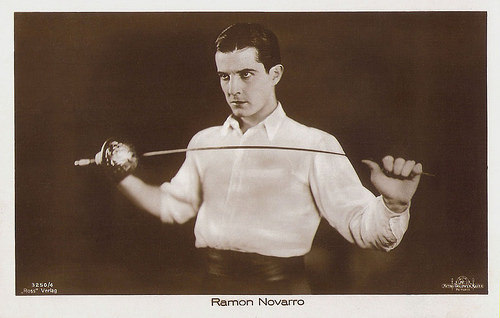
German postcard by Ross Verlag, no. 3250/4, 1928-1929. Photo: MGM.
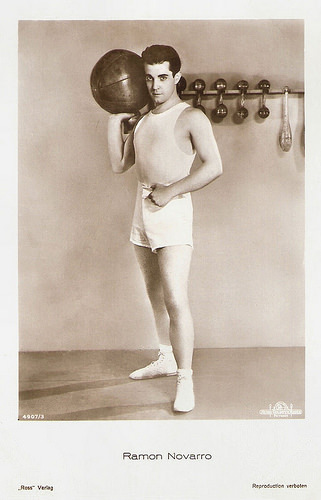
German postcard by Ross Verlag, no. 4907/3/4, 1929-1930. Photo: MGM.
The New ValentinoRamon Novarro was born as Jose Ramón Gil Samaniego in 1899 in Durango, Mexico. His parents were Leonor (Gavilan) and Dr. Mariano N. Samaniego Siqueiros, a prosperous dentist. Ramon and his family moved to Los Angeles in 1913, as refugees from the Mexican Revolution. He was a second cousin of the Mexican film star Dolores del Rio.
The family's wealth having been left behind, young Novarro took on a number of odd jobs, ranging from ballet dancer, piano teacher and singing waiter. In 1917, he became a film extra. Ramon worked as an extra until director Rex Ingram cast him as the lovable scoundrel Rupert of Hentzau in The Prisoner of Zenda (1922) with Lewis Stone and Alice Terry. Ramon scored an immediate hit. He was billed as Ramon Samaniegos and Terry suggested that he would change his name to Novarro. And so he did.
Ramon Novarro worked with Ingram in his next four films. Ingram again teamed him with Terry and Stone in the successful costume adventure Scaramouche (Rex Ingram, 1923). Novarro played a law student who becomes an outlaw French revolutionary when he decides to avenge the unjust killing of his friend. Ron Oliver at IMDb : "Novarro, taking the hero role this time, proved he was no flash in the pan. Equally adept as sensitive lover or dueling revolutionary, with this performance Novarro was catapulted to Hollywood's upper ranks."
Novarro's rising popularity among female moviegoers resulted in his being billed as the 'New Valentino' and as 'The Latin Lover'. In 1925 he appeared in his most famous role, as Judah Ben-Hur in Ben-Hur: A Tale of the Christ (Fred Niblo, 1925). At IMDb , John Nicolaus reviews: "I found Roman Navarro far more likable in the title role than Charlton Heston. Like with most silent films, Navarro is a bit over the top, but he's still portrayed as honest and kind, yet proud figure. He also has a very kind face, which helps the audience 'fall' for this guy."
With Valentino's death in 1926, Novarro became the screen's leading Latin actor. He co-starred with Norma Shearer in The Student Prince in Old Heidelberg (Ernst Lubitsch, 1927). Lubitsch made an enjoyable Viennese fairy tale in which Novarro played a cloistered, overprotected Austrian prince who falls in love with a down-to-earth barmaid (Shearer).
Ron Oliver at IMDb : "This wonderful, exuberant, heartbreaking film - one of the last major movies of the Silent Era - is a scintillating example of the artistry of director Ernst Lubitsch. Filled with wry humor & aching pathos, Lubitsch tells a tale which is a persuasive paean to the power of the talkless film. Ramon Novarro, always eager to please his audience, brings great charm to the title role. Although about 10 years too old to be playing a typical university freshman, he nonetheless brings tremendous enthusiasm to the role."
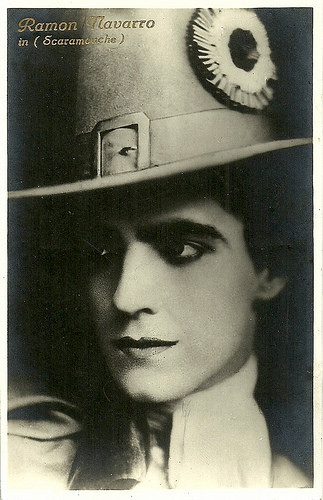
Italian postcard by Ed. Vettori, Bologna. Photo: Ramon Novarro in the period piece Scaramouche (Rex Ingram, 1923).
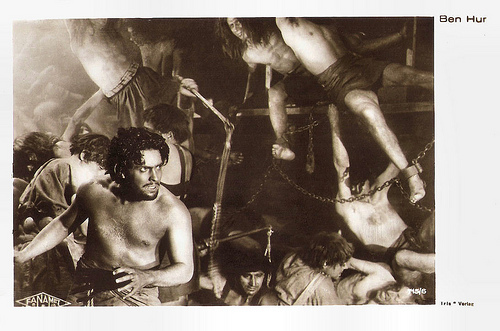
Austrian postcard by Iris Verlag, no. 715/6. Photo: FaNaMet. Publicity still for Ben-Hur: A Tale of the Christ (Fred Niblo, 1925).
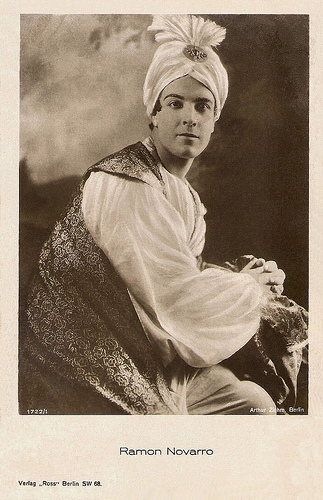
German postcard by Ross Verlag, no. 1722/1, 1927-1928. Photo: Arthur Ziehm, Berlin. Novarro is dressed in the attire of his film A Lover's Oath (Ferdinand P. Earle, 1925), based on Edward Fitzgerald's The Rubaiyat of Omar Khayyam, the Astronomer-Poet of Persia. From this film only a short clip remains.
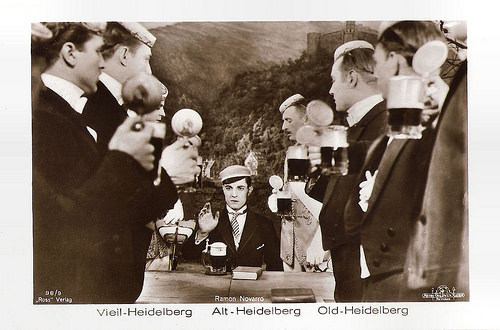
German postcard by Ross Verlag, no. 98/9. Photo: Metro-Goldwyn-Mayer. Publicity still for The Student Prince of Old Heidelberg (Ernst Lubitsch, 1927).
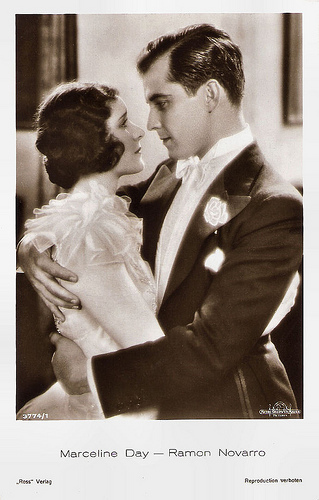
German postcard by Ross Verlag, no. 3774/2, 1928-1929. Photo: Metro-Goldwyn-Mayer. Publicity still for A Certain Young Man (Hobart Henley, 1928) with Marceline Day.
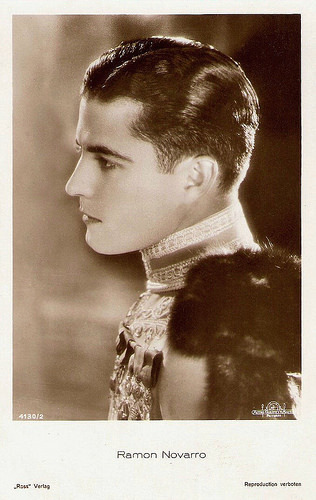
German postcard by Ross-Verlag, no. 4130/2, 1929-1930. Photo: Metro-Goldwyn-Mayer. Publicity still for Forbidden Hours (Harry Beaumont, 1928).
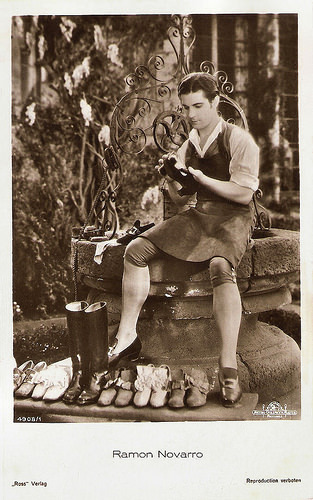
German postcard by Ross Verlag, Berlin, no. 4908/1, 1929-1930. Photo: MGM. Publicity still for Devil-May-Care (Sidney Franklin, 1929).
Savagely beaten by two young hustlers
At the peak of his success in the late 1920s and early 1930s, Ramon Novarro was earning more than US$100,000 per film. His first talking picture was Call of the Flesh (Charles Brabin, 1930), where he sang and danced the tango. He continued to appear in musicals, but his popularity was slipping. MGM insisted on giving their Mexican star a wide range of ethnic parts, everything from a carefree South Seas native in The Pagan (W.S. Van Dyke, 1929) to a wealthy Indian jewel merchant in Son of India (Jacques Feyder, 1931).
He was not given many topnotch assignments, but he did star with Greta Garbo in the Mata Hari (George Fitzmaurice, 1931), a semi-fictionalized account of the life of the exotic dancer who was accused of spying for Germany during World War I. She falls in love for the first and only time in her life when she meets dazzlingly handsome lieutenant Ramon Novarro. Ron Oliver at IMDb : "Ramon Novarro, who receives co-equal billing with Garbo, had been an important movie celebrity far longer than she, but her rising sun tended to obscure most other stars in her orbit and Novarro has to work hard to get much notice in their joint scenes. As always, MGM's chameleon actor (this time he plays a Russian) gives a very competent performance, but as a romantic pair they make a rather unusual couple - which simply means that Novarro's sexual ambiguity is perfectly mirrored by Garbo's intrinsic androgyny."
Mata Hari was a success, but soon Novarro's career began to fade fast. In 1935 he left MGM and appeared on Broadway in a show that quickly flopped. Though wealthy enough not to need work, Novarro was restless when not before the cameras. His later career, consisted mostly of cameos. In Europe he was still popular. In France he starred in La comédie du bonheur/Comedy of Happiness (Marcel L'Herbier, 1940) opposite Michel Simon. He also appeared in the Italian version, Ecco la felicità (Marcel L'Herbier, 1940). In Mexico, he starred in La virgen que forjó una patria/The Saint That Forged a Country (Julio Bracho, 1942).
After the war, Novarro returned to Hollywood as a supporting actor and appeared in such films as We Were Strangers (John Huston, 1949) and the Film Noir The Big Steal (Don Siegel, 1949), starring Robert Mitchum. His last film was Heller in Pink Tights (George Cukor, 1960) with Sophia Loren. Later he guest-starred in TV series such as Rawhide (1964), Bonanza (1965) and The High Chaparral (1968).
Ramon Novarro was troubled all his life by his conflicted feelings toward his Roman Catholic religion and his homosexuality. His life-long struggle with alcoholism is often traced to these issues. He was romantically involved with journalist Herbert Howe, who was also his publicist in the late 1920s. In 1968, Novarro was savagely beaten in his North Hollywood home by two young hustlers, the brothers Paul and Tom Ferguson, aged 22 and 17. They had heard - in error - that a large sum of money was locked away somewhere in his home. They never found any money, and Novarro was discovered dead the next day by his servant. Novarro died as a result of asphyxiation—having choked to death on his own blood after being beaten. He was less than four months away from what would have been his 70th birthday.
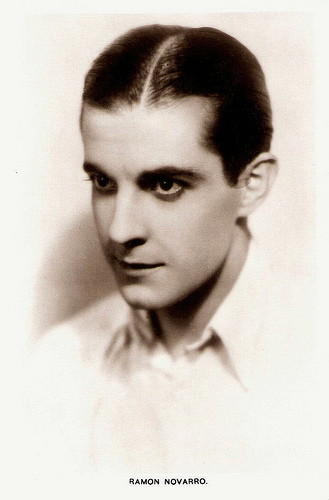
British postcard in the Picturegoer Series, London, no. 58b.
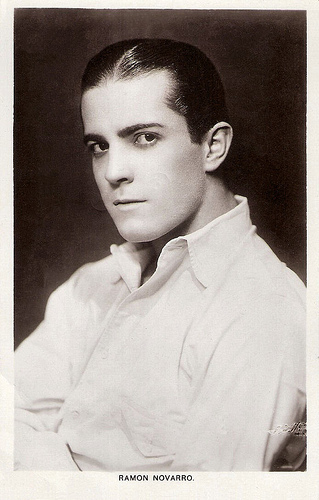
British postcard in the Picturegoer Series, London, no. 93. Sent by mail in 1931.
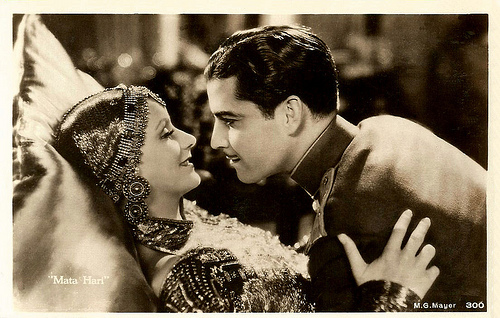
Dutch postcard, no. 300. Photo: Metro-Goldwyn-Mayer. Ramon Novarro and Greta Garbo in Mata Hari (George Fitzmaurice, 1931).
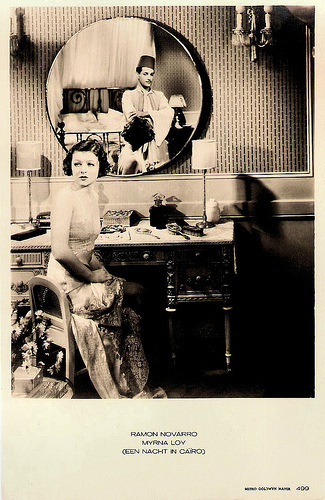
Dutch postcard, no. 499. Photo: Metro-Goldwyn-Mayer. Publicity still for The Barbarian (Sam Wood, 1933) with Myrna Loy.
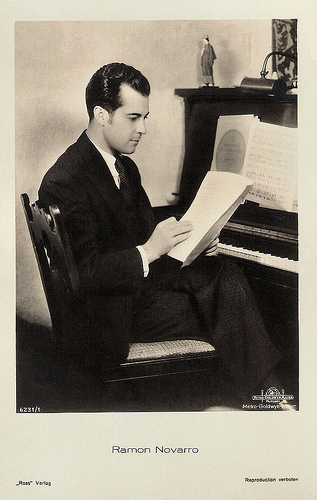
German postcard by Ross Verlag, no. 6231/1, 1931-1932. Photo: Metro-Goldwyn-Mayer.
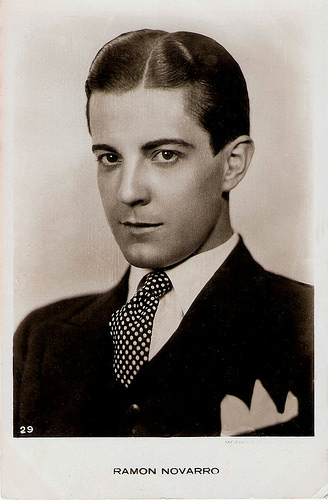
Dutch postcard, no. 29.
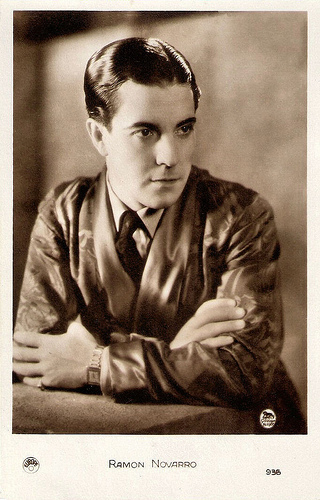
French postcard by Europe, no. 936. Sent by mail in the Netherlands in 1932. Photo: MGM.
Source: Hal Erickson (AllMovie), (IMDb), TCM, Wikipedia and .

Italian postcard by Ed. Vettori, Bologna, no. 932. Ramon Novarro holding a sketch for the period piece Scaramouche (Rex Ingram, 1923), in which Novarro had the title role. The film, produced by Metro Pictures, was based on a novel by Rafael Sabatini, and co-starred Alice Terry and Lewis Stone.

German postcard by Ross Verlag, no. 1486/2, 1927-1928. Photo: MGM / ParUfaMet.

Austrian postcard by Iris-Verlag, no. 753/2. Photo: Fanamet-Film.

German postcard by Ross Verlag, no. 3250/4, 1928-1929. Photo: MGM.

German postcard by Ross Verlag, no. 4907/3/4, 1929-1930. Photo: MGM.
The New ValentinoRamon Novarro was born as Jose Ramón Gil Samaniego in 1899 in Durango, Mexico. His parents were Leonor (Gavilan) and Dr. Mariano N. Samaniego Siqueiros, a prosperous dentist. Ramon and his family moved to Los Angeles in 1913, as refugees from the Mexican Revolution. He was a second cousin of the Mexican film star Dolores del Rio.
The family's wealth having been left behind, young Novarro took on a number of odd jobs, ranging from ballet dancer, piano teacher and singing waiter. In 1917, he became a film extra. Ramon worked as an extra until director Rex Ingram cast him as the lovable scoundrel Rupert of Hentzau in The Prisoner of Zenda (1922) with Lewis Stone and Alice Terry. Ramon scored an immediate hit. He was billed as Ramon Samaniegos and Terry suggested that he would change his name to Novarro. And so he did.
Ramon Novarro worked with Ingram in his next four films. Ingram again teamed him with Terry and Stone in the successful costume adventure Scaramouche (Rex Ingram, 1923). Novarro played a law student who becomes an outlaw French revolutionary when he decides to avenge the unjust killing of his friend. Ron Oliver at IMDb : "Novarro, taking the hero role this time, proved he was no flash in the pan. Equally adept as sensitive lover or dueling revolutionary, with this performance Novarro was catapulted to Hollywood's upper ranks."
Novarro's rising popularity among female moviegoers resulted in his being billed as the 'New Valentino' and as 'The Latin Lover'. In 1925 he appeared in his most famous role, as Judah Ben-Hur in Ben-Hur: A Tale of the Christ (Fred Niblo, 1925). At IMDb , John Nicolaus reviews: "I found Roman Navarro far more likable in the title role than Charlton Heston. Like with most silent films, Navarro is a bit over the top, but he's still portrayed as honest and kind, yet proud figure. He also has a very kind face, which helps the audience 'fall' for this guy."
With Valentino's death in 1926, Novarro became the screen's leading Latin actor. He co-starred with Norma Shearer in The Student Prince in Old Heidelberg (Ernst Lubitsch, 1927). Lubitsch made an enjoyable Viennese fairy tale in which Novarro played a cloistered, overprotected Austrian prince who falls in love with a down-to-earth barmaid (Shearer).
Ron Oliver at IMDb : "This wonderful, exuberant, heartbreaking film - one of the last major movies of the Silent Era - is a scintillating example of the artistry of director Ernst Lubitsch. Filled with wry humor & aching pathos, Lubitsch tells a tale which is a persuasive paean to the power of the talkless film. Ramon Novarro, always eager to please his audience, brings great charm to the title role. Although about 10 years too old to be playing a typical university freshman, he nonetheless brings tremendous enthusiasm to the role."

Italian postcard by Ed. Vettori, Bologna. Photo: Ramon Novarro in the period piece Scaramouche (Rex Ingram, 1923).

Austrian postcard by Iris Verlag, no. 715/6. Photo: FaNaMet. Publicity still for Ben-Hur: A Tale of the Christ (Fred Niblo, 1925).

German postcard by Ross Verlag, no. 1722/1, 1927-1928. Photo: Arthur Ziehm, Berlin. Novarro is dressed in the attire of his film A Lover's Oath (Ferdinand P. Earle, 1925), based on Edward Fitzgerald's The Rubaiyat of Omar Khayyam, the Astronomer-Poet of Persia. From this film only a short clip remains.

German postcard by Ross Verlag, no. 98/9. Photo: Metro-Goldwyn-Mayer. Publicity still for The Student Prince of Old Heidelberg (Ernst Lubitsch, 1927).

German postcard by Ross Verlag, no. 3774/2, 1928-1929. Photo: Metro-Goldwyn-Mayer. Publicity still for A Certain Young Man (Hobart Henley, 1928) with Marceline Day.

German postcard by Ross-Verlag, no. 4130/2, 1929-1930. Photo: Metro-Goldwyn-Mayer. Publicity still for Forbidden Hours (Harry Beaumont, 1928).

German postcard by Ross Verlag, Berlin, no. 4908/1, 1929-1930. Photo: MGM. Publicity still for Devil-May-Care (Sidney Franklin, 1929).
Savagely beaten by two young hustlers
At the peak of his success in the late 1920s and early 1930s, Ramon Novarro was earning more than US$100,000 per film. His first talking picture was Call of the Flesh (Charles Brabin, 1930), where he sang and danced the tango. He continued to appear in musicals, but his popularity was slipping. MGM insisted on giving their Mexican star a wide range of ethnic parts, everything from a carefree South Seas native in The Pagan (W.S. Van Dyke, 1929) to a wealthy Indian jewel merchant in Son of India (Jacques Feyder, 1931).
He was not given many topnotch assignments, but he did star with Greta Garbo in the Mata Hari (George Fitzmaurice, 1931), a semi-fictionalized account of the life of the exotic dancer who was accused of spying for Germany during World War I. She falls in love for the first and only time in her life when she meets dazzlingly handsome lieutenant Ramon Novarro. Ron Oliver at IMDb : "Ramon Novarro, who receives co-equal billing with Garbo, had been an important movie celebrity far longer than she, but her rising sun tended to obscure most other stars in her orbit and Novarro has to work hard to get much notice in their joint scenes. As always, MGM's chameleon actor (this time he plays a Russian) gives a very competent performance, but as a romantic pair they make a rather unusual couple - which simply means that Novarro's sexual ambiguity is perfectly mirrored by Garbo's intrinsic androgyny."
Mata Hari was a success, but soon Novarro's career began to fade fast. In 1935 he left MGM and appeared on Broadway in a show that quickly flopped. Though wealthy enough not to need work, Novarro was restless when not before the cameras. His later career, consisted mostly of cameos. In Europe he was still popular. In France he starred in La comédie du bonheur/Comedy of Happiness (Marcel L'Herbier, 1940) opposite Michel Simon. He also appeared in the Italian version, Ecco la felicità (Marcel L'Herbier, 1940). In Mexico, he starred in La virgen que forjó una patria/The Saint That Forged a Country (Julio Bracho, 1942).
After the war, Novarro returned to Hollywood as a supporting actor and appeared in such films as We Were Strangers (John Huston, 1949) and the Film Noir The Big Steal (Don Siegel, 1949), starring Robert Mitchum. His last film was Heller in Pink Tights (George Cukor, 1960) with Sophia Loren. Later he guest-starred in TV series such as Rawhide (1964), Bonanza (1965) and The High Chaparral (1968).
Ramon Novarro was troubled all his life by his conflicted feelings toward his Roman Catholic religion and his homosexuality. His life-long struggle with alcoholism is often traced to these issues. He was romantically involved with journalist Herbert Howe, who was also his publicist in the late 1920s. In 1968, Novarro was savagely beaten in his North Hollywood home by two young hustlers, the brothers Paul and Tom Ferguson, aged 22 and 17. They had heard - in error - that a large sum of money was locked away somewhere in his home. They never found any money, and Novarro was discovered dead the next day by his servant. Novarro died as a result of asphyxiation—having choked to death on his own blood after being beaten. He was less than four months away from what would have been his 70th birthday.

British postcard in the Picturegoer Series, London, no. 58b.

British postcard in the Picturegoer Series, London, no. 93. Sent by mail in 1931.

Dutch postcard, no. 300. Photo: Metro-Goldwyn-Mayer. Ramon Novarro and Greta Garbo in Mata Hari (George Fitzmaurice, 1931).

Dutch postcard, no. 499. Photo: Metro-Goldwyn-Mayer. Publicity still for The Barbarian (Sam Wood, 1933) with Myrna Loy.

German postcard by Ross Verlag, no. 6231/1, 1931-1932. Photo: Metro-Goldwyn-Mayer.

Dutch postcard, no. 29.

French postcard by Europe, no. 936. Sent by mail in the Netherlands in 1932. Photo: MGM.
Source: Hal Erickson (AllMovie), (IMDb), TCM, Wikipedia and .
Published on January 19, 2016 22:00
January 18, 2016
Monica Vitti
Original and versatile Monica Vitti (1931) is one of Italy's most famous actresses of the 20th century. She is most widely noted in the early 1960s for her starring roles in four classic avant-garde films directed by Michelangelo Antonioni. Later the glamorous blonde became the queen of the commedia all’italiana, a film genre previously restricted to men.

French postcard by PSG for Corvisart, Epinal, no. 437. Photo: Sam Lévin.
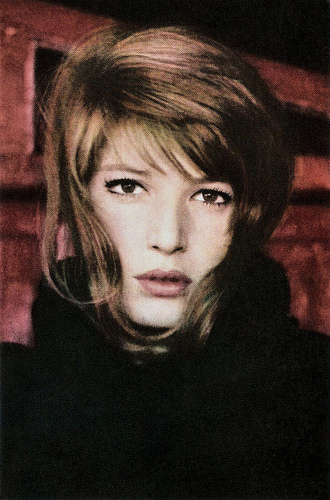
Romanian postcard by Casa Filmului Acin, no. 97.
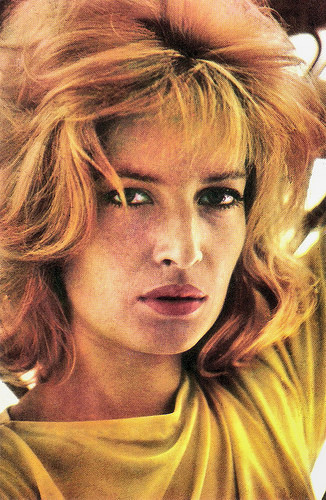
Romanian postcard by Casa Filmului Acin, no. 125.
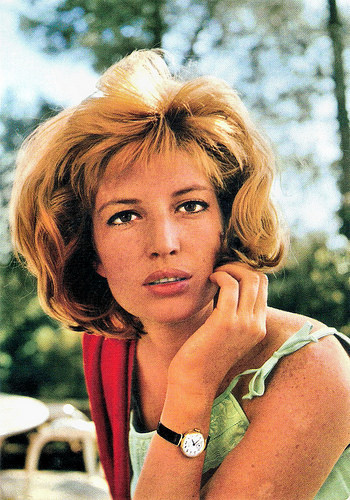
Italian postcard by Rotalcolor, no. 146.
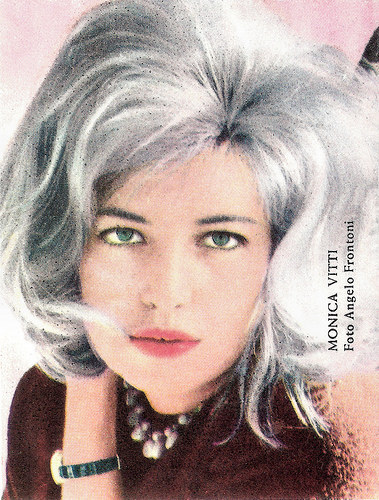
Vintage collectors card. Photo: Angelo Frontoni.
Turning Point
Monica Vitti was born Maria Luisa Ceciarelli in Rome, in 1931. She studied at Pittman's College, where she played as a teen in a charity performance of Dario Niccodemi's La nemica (The Enemy). She then trained as an actor at the Accademia Nazionale d'Arte Drammatica (Rome's National Academy of Dramatic Arts) where she graduated in 1953.
She toured Germany with an Italian acting troupe and her first stage appearance in Rome was for a production of Niccolò Machiavelli's La Mandrogola (The Mandrogola). Vitti's film debut was an uncredited bit part in the comedy Ridere! Ridere! Ridere!/Laugh! Laugh! Laugh! (Edoardo Anton, 1954) with Tino Scotti and Ugo Tognazzi . Her first widely noted performance was at the age of 26 in the comedy Le dritte/Smart Girls (Mario Amendola, 1958) starring Franco Fabrizi .
A turning point in her career came in 1957 when she joined Michelangelo Antonioni's Teatro Nuovo di Milano. Three years later she played a leading role in his internationally praised and award winning film L'avventura/The Adventure (Michelangelo Antonioni, 1960).
In L’avventura a group of rich Italians head out on a yachting trip to a deserted volcanic island in the Mediterranean. When they are about to leave the island, they find Anna (Lea Massari), the main character up to this point, has gone missing. Sandro, Anna's boyfriend, and Claudia (Monica Vitti), Anna's friend, try without success to find her. While looking Anna, Claudia and Sandro develop an attraction for each other. They proceed to become lovers, and all but forget about the missing Anna.
Vitti as the detached and cool Claudia gave a stunning screen presence. She also helped Antonioni raise money for the production and stuck with him through daunting location shooting. L'avventura made Vitti an international star and one of Italy's most famous actresses of the 20th century. Her image later even appeared on an Italian postage stamp commemorating the film.
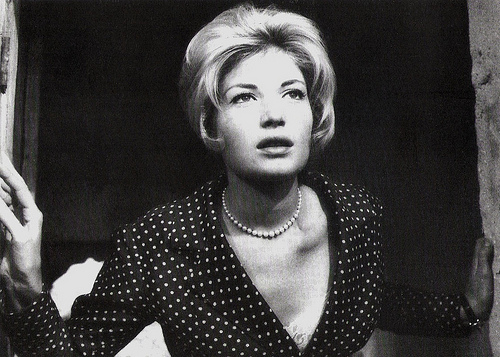
British postcard by BFI and The Screen on the Hill, for the British re-release in 1995. Photo: publicity still for L'Avventura (Michelangelo Antonioni, 1960).
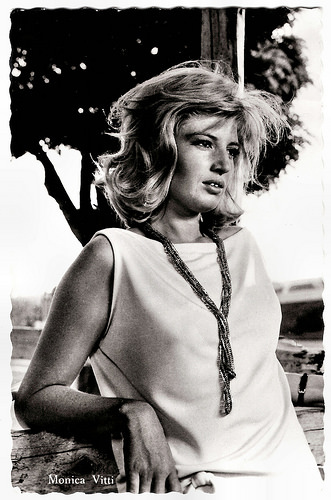
Dutch postcard by De Muinck en Co, Amsterdam, no. 809. Photo: publicity still for L'eclisse/The Eclypse (Michelangelo Antonioni, 1962).
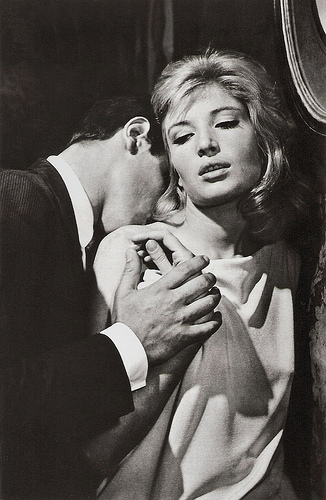
Romanian postcard by Casa Filmului Acin. Photo: publicity still for L'eclisse/The Eclypse (Michelangelo Antonioni, 1962) with Alain Delon .
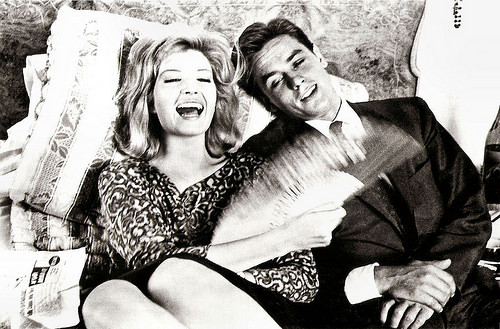
Romanian postcard by Casa Filmului Acin. Photo: publicity still for L'eclisse/The Eclypse (Michelangelo Antonioni, 1962) with Alain Delon .
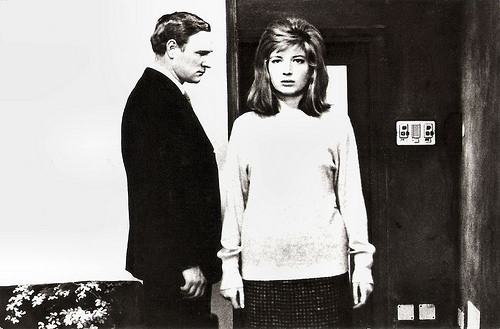
Romanian postcard by Casa Filmului Acin, no. 322. Photo: publicity still for Il deserto rosso/Red Desert (Michelangelo Antonioni, 1964) with Richard Harris.
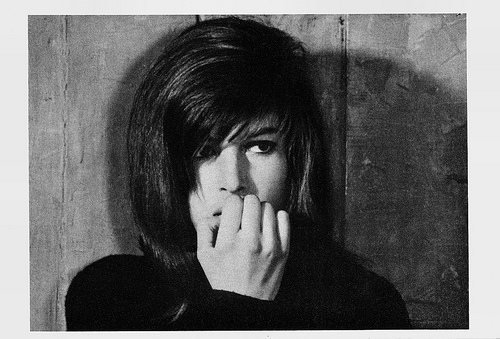
French postcard by Editions La Malibran, Paris, no CI 3. Photo: Carlo di Palma. Publicity still for Il deserto rosso/Red Desert (Michelangelo Antonioni, 1964).
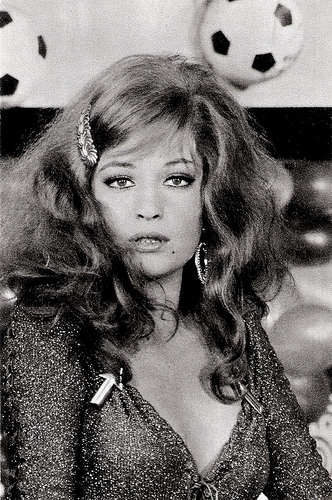
Yugoslavian collectors card by Atheneum, 1971. Photo: Kepes Film.
Modernist Consciousness in the 1960s
Monica Vitti received more critical praise for her starring roles in the next three Antonioni films La notte/The Night (Michelangelo Antonioni, 1961), L'eclisse/The Eclipse (Michelangelo Antonioni, 1962) and Il deserto rosso/The Red Desert (Michelangelo Antonioni, 1964), which are often cited with L'avventura as a series.
In the four films Antonioni explores modernist consciousness in the 1960’s. In her portrayal of deeply troubled middle-class women, unable to establish satisfying relationships and incapable of connecting with their environment, the beautiful Vitti came to embody the modernist dilemma in all its complexity and angst.
Hal Erickson at AllMovie even calls her ‘The high priestess of frosty sensuality’. In La Notte she plays the daughter of a wealthy industrialist who tries to inaugurate an empty affair with a married author, played by Marcello Mastroianni . In L’eclisse she plays Vittoria, a young translator who meets the vital broker Piero ( Alain Delon ) during a crash in the Stock Market but the love affair is doomed because of Piero’s materialistic nature. In Il deserto rosso she was Guiliana, a housewife married to a factory manager. She is mentally ill, but hides it from her husband as best she can. She meets the engineer Zeller (Richard Harris) who takes advantage of her distress, and then she is again alone and ill.
She also starred in films by other directors, such as Château en Suède/Nutty Naughty Chateau (Roger Vadim, 1963) with Jean-Claude Brialy , and the comedy Il disco volante/The Flying Saucer (Tinto Brass, 1964) with Alberto Sordi and Silvana Mangano .
Vitti appeared in only two English language films. She starred in the title role of Joseph Losey's Modesty Blaise (1966), a mod James Bond spy spoof with Terence Stamp and Dirk Bogarde which had only mixed success and received harsh critical reviews. Her second English language film was An Almost Perfect Affair (Michael Ritchie, 1979) with Keith Carradine, which takes place during the Cannes Film Festival.
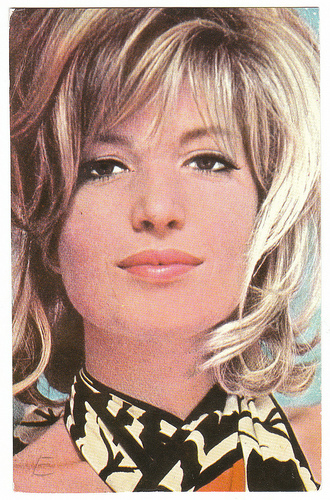
Vintage postcard. Collection: Véronique.
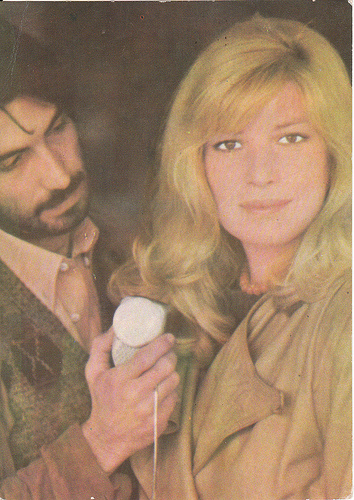
Romanian postcard by Casa Filmului Acin. Collection: Véronique.
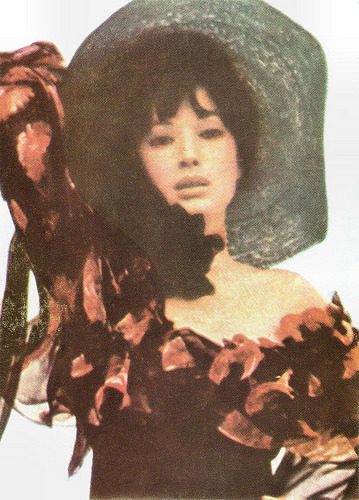
Romanian postcard by Casa Filmului Acin.
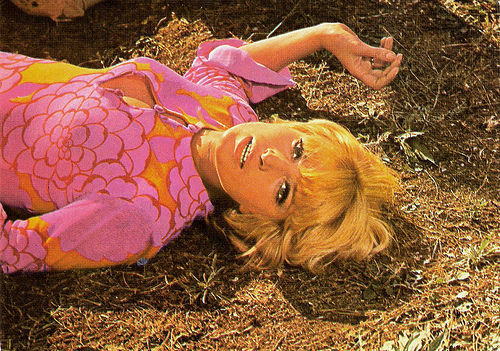
Romanian postcard by Casa Filmului Acin.
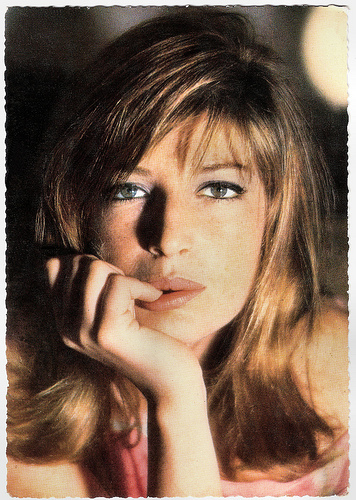
French postcard by E.D.U.G., no. 437. Photo: Sam Lévin.
Secret Scandal
In the mid 1960s Monica Vitti decided to switch genre, and returned to the light comedy that was clearly her forte. After a few uncertain performances, she gained enormous public recognition with La ragazza con la pistol/The Girl with a Pistol (Mario Monicelli, 1968), in which she plays the unlikely role of a Sicilian woman seeking revenge in London.
She achieved ever greater success in Amore mio, aiutami/Help Me My Love (Alberto Sordi, 1969), on the theme of marital infidelity, and Scola's romantic comedy Dramma della gelosia/The Pizza Triangle (Ettore Scola, 1970) about a working-class love triangle with Marcello Mastroianni and Giancarlo Giannini.
Throughout the 1970s Monica Vitti appeared mostly in Italian films which did not have international distribution. There were a few exceptions. She starred in Buñuel's innovative Le Fantôme de la liberté/The Phantom of Liberty (Luis Buñuel, 1974) and the political thriller La raison d'état/State Reasons (André Cayatte, 1978) with Jean Yanne. In 1974 she won the David di Donatello award for Best Actress in Polvere di stele/Stardust (Alberto Sordi, 1973), an emotional recreation of the world of variety. She won this Italian award five times.
In 1980 after 15 years she reunited with Antonioni for his Il mistero di Oberwald/The Mystery of Oberwald (Michelangelo Antonioni, 1980) which was one of the first major international feature films to be shot on video. Based on a screenplay by Jean Cocteau it tells the story of fugitive Sebastian (Franco Branciaroli), who breaks into the castle at Oberwald to kill the Queen (Monica Vitti), but faints before doing so. He is the splitting image of the King who was assassinated on his wedding day. The Queen discovers that Sebastian once wrote a subversive poem that she liked, even though it was attacking her. The Queen dares Sebastian to kill her, otherwise she vows to kill him.
During the 1980s Monica Vitti did much less screen work. By 1986 she had returned to the theatre as an actress and teacher. In 1989, Vitti wrote, directed and starred in Scandalo Segreto/Secret Scandal (1989) with Elliot Gould. The film was well received critically but met with limited box-office success. She then retired from the cinema. During the 1990s she did television work, both acting and directing. In 1993 she was awarded the Festival Tribute at the Créteil International Women's Film Festival in France.
In 1995 Monica Vitti married photographer Roberto Russo, with whom she had lived since 1975. Alzheimer's disease has removed her from the public gaze for the last 15 years.
DVD Trailer of L'avventura/The Adventure (1960). Source: Criterion Trailers (YouTube).
Trailer of La notte/The Night (1961). Source: Criterion Collection (YouTube).
Re-release trailer of L'eclisse/The Eclipse (1962). Source: STUDIOCANAL UK (YouTube).
DVD Trailer of Il deserto rosso/The Red Desert (1964). Source: Criterion Trailers (YouTube).
Trailer of Modesty Blaise (1966). Source: PVR Pictures (YouTube).
Sources: Hal Erickson (AllMovie), MonicaVitti.com, Rodney Farnsworth (Film Reference), Lenin Imports, Wikipedia and .

French postcard by PSG for Corvisart, Epinal, no. 437. Photo: Sam Lévin.

Romanian postcard by Casa Filmului Acin, no. 97.

Romanian postcard by Casa Filmului Acin, no. 125.

Italian postcard by Rotalcolor, no. 146.

Vintage collectors card. Photo: Angelo Frontoni.
Turning Point
Monica Vitti was born Maria Luisa Ceciarelli in Rome, in 1931. She studied at Pittman's College, where she played as a teen in a charity performance of Dario Niccodemi's La nemica (The Enemy). She then trained as an actor at the Accademia Nazionale d'Arte Drammatica (Rome's National Academy of Dramatic Arts) where she graduated in 1953.
She toured Germany with an Italian acting troupe and her first stage appearance in Rome was for a production of Niccolò Machiavelli's La Mandrogola (The Mandrogola). Vitti's film debut was an uncredited bit part in the comedy Ridere! Ridere! Ridere!/Laugh! Laugh! Laugh! (Edoardo Anton, 1954) with Tino Scotti and Ugo Tognazzi . Her first widely noted performance was at the age of 26 in the comedy Le dritte/Smart Girls (Mario Amendola, 1958) starring Franco Fabrizi .
A turning point in her career came in 1957 when she joined Michelangelo Antonioni's Teatro Nuovo di Milano. Three years later she played a leading role in his internationally praised and award winning film L'avventura/The Adventure (Michelangelo Antonioni, 1960).
In L’avventura a group of rich Italians head out on a yachting trip to a deserted volcanic island in the Mediterranean. When they are about to leave the island, they find Anna (Lea Massari), the main character up to this point, has gone missing. Sandro, Anna's boyfriend, and Claudia (Monica Vitti), Anna's friend, try without success to find her. While looking Anna, Claudia and Sandro develop an attraction for each other. They proceed to become lovers, and all but forget about the missing Anna.
Vitti as the detached and cool Claudia gave a stunning screen presence. She also helped Antonioni raise money for the production and stuck with him through daunting location shooting. L'avventura made Vitti an international star and one of Italy's most famous actresses of the 20th century. Her image later even appeared on an Italian postage stamp commemorating the film.

British postcard by BFI and The Screen on the Hill, for the British re-release in 1995. Photo: publicity still for L'Avventura (Michelangelo Antonioni, 1960).

Dutch postcard by De Muinck en Co, Amsterdam, no. 809. Photo: publicity still for L'eclisse/The Eclypse (Michelangelo Antonioni, 1962).

Romanian postcard by Casa Filmului Acin. Photo: publicity still for L'eclisse/The Eclypse (Michelangelo Antonioni, 1962) with Alain Delon .

Romanian postcard by Casa Filmului Acin. Photo: publicity still for L'eclisse/The Eclypse (Michelangelo Antonioni, 1962) with Alain Delon .

Romanian postcard by Casa Filmului Acin, no. 322. Photo: publicity still for Il deserto rosso/Red Desert (Michelangelo Antonioni, 1964) with Richard Harris.

French postcard by Editions La Malibran, Paris, no CI 3. Photo: Carlo di Palma. Publicity still for Il deserto rosso/Red Desert (Michelangelo Antonioni, 1964).

Yugoslavian collectors card by Atheneum, 1971. Photo: Kepes Film.
Modernist Consciousness in the 1960s
Monica Vitti received more critical praise for her starring roles in the next three Antonioni films La notte/The Night (Michelangelo Antonioni, 1961), L'eclisse/The Eclipse (Michelangelo Antonioni, 1962) and Il deserto rosso/The Red Desert (Michelangelo Antonioni, 1964), which are often cited with L'avventura as a series.
In the four films Antonioni explores modernist consciousness in the 1960’s. In her portrayal of deeply troubled middle-class women, unable to establish satisfying relationships and incapable of connecting with their environment, the beautiful Vitti came to embody the modernist dilemma in all its complexity and angst.
Hal Erickson at AllMovie even calls her ‘The high priestess of frosty sensuality’. In La Notte she plays the daughter of a wealthy industrialist who tries to inaugurate an empty affair with a married author, played by Marcello Mastroianni . In L’eclisse she plays Vittoria, a young translator who meets the vital broker Piero ( Alain Delon ) during a crash in the Stock Market but the love affair is doomed because of Piero’s materialistic nature. In Il deserto rosso she was Guiliana, a housewife married to a factory manager. She is mentally ill, but hides it from her husband as best she can. She meets the engineer Zeller (Richard Harris) who takes advantage of her distress, and then she is again alone and ill.
She also starred in films by other directors, such as Château en Suède/Nutty Naughty Chateau (Roger Vadim, 1963) with Jean-Claude Brialy , and the comedy Il disco volante/The Flying Saucer (Tinto Brass, 1964) with Alberto Sordi and Silvana Mangano .
Vitti appeared in only two English language films. She starred in the title role of Joseph Losey's Modesty Blaise (1966), a mod James Bond spy spoof with Terence Stamp and Dirk Bogarde which had only mixed success and received harsh critical reviews. Her second English language film was An Almost Perfect Affair (Michael Ritchie, 1979) with Keith Carradine, which takes place during the Cannes Film Festival.

Vintage postcard. Collection: Véronique.

Romanian postcard by Casa Filmului Acin. Collection: Véronique.

Romanian postcard by Casa Filmului Acin.

Romanian postcard by Casa Filmului Acin.

French postcard by E.D.U.G., no. 437. Photo: Sam Lévin.
Secret Scandal
In the mid 1960s Monica Vitti decided to switch genre, and returned to the light comedy that was clearly her forte. After a few uncertain performances, she gained enormous public recognition with La ragazza con la pistol/The Girl with a Pistol (Mario Monicelli, 1968), in which she plays the unlikely role of a Sicilian woman seeking revenge in London.
She achieved ever greater success in Amore mio, aiutami/Help Me My Love (Alberto Sordi, 1969), on the theme of marital infidelity, and Scola's romantic comedy Dramma della gelosia/The Pizza Triangle (Ettore Scola, 1970) about a working-class love triangle with Marcello Mastroianni and Giancarlo Giannini.
Throughout the 1970s Monica Vitti appeared mostly in Italian films which did not have international distribution. There were a few exceptions. She starred in Buñuel's innovative Le Fantôme de la liberté/The Phantom of Liberty (Luis Buñuel, 1974) and the political thriller La raison d'état/State Reasons (André Cayatte, 1978) with Jean Yanne. In 1974 she won the David di Donatello award for Best Actress in Polvere di stele/Stardust (Alberto Sordi, 1973), an emotional recreation of the world of variety. She won this Italian award five times.
In 1980 after 15 years she reunited with Antonioni for his Il mistero di Oberwald/The Mystery of Oberwald (Michelangelo Antonioni, 1980) which was one of the first major international feature films to be shot on video. Based on a screenplay by Jean Cocteau it tells the story of fugitive Sebastian (Franco Branciaroli), who breaks into the castle at Oberwald to kill the Queen (Monica Vitti), but faints before doing so. He is the splitting image of the King who was assassinated on his wedding day. The Queen discovers that Sebastian once wrote a subversive poem that she liked, even though it was attacking her. The Queen dares Sebastian to kill her, otherwise she vows to kill him.
During the 1980s Monica Vitti did much less screen work. By 1986 she had returned to the theatre as an actress and teacher. In 1989, Vitti wrote, directed and starred in Scandalo Segreto/Secret Scandal (1989) with Elliot Gould. The film was well received critically but met with limited box-office success. She then retired from the cinema. During the 1990s she did television work, both acting and directing. In 1993 she was awarded the Festival Tribute at the Créteil International Women's Film Festival in France.
In 1995 Monica Vitti married photographer Roberto Russo, with whom she had lived since 1975. Alzheimer's disease has removed her from the public gaze for the last 15 years.
DVD Trailer of L'avventura/The Adventure (1960). Source: Criterion Trailers (YouTube).
Trailer of La notte/The Night (1961). Source: Criterion Collection (YouTube).
Re-release trailer of L'eclisse/The Eclipse (1962). Source: STUDIOCANAL UK (YouTube).
DVD Trailer of Il deserto rosso/The Red Desert (1964). Source: Criterion Trailers (YouTube).
Trailer of Modesty Blaise (1966). Source: PVR Pictures (YouTube).
Sources: Hal Erickson (AllMovie), MonicaVitti.com, Rodney Farnsworth (Film Reference), Lenin Imports, Wikipedia and .
Published on January 18, 2016 22:00
January 17, 2016
Henri Garat
‘Beau garcon’ Henri Garat (1902-1959) was a popular singer and leading man in light romances during the 1930s. As the partner of Lilian Harvey in French adaptations of her film operettas he became a big star.
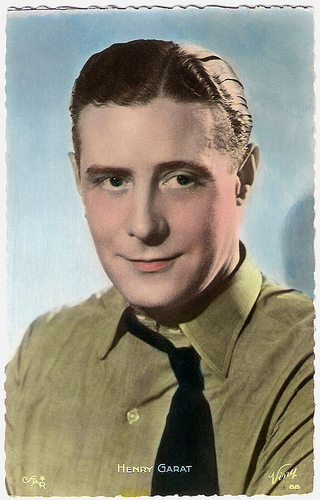
French postcard by Viny, no. 68. Photo: Star.
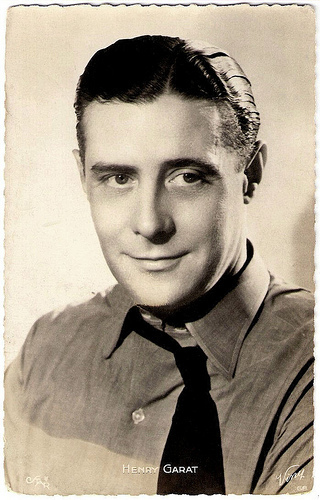
French postcard by Viny, no. 68. Photo: Star.
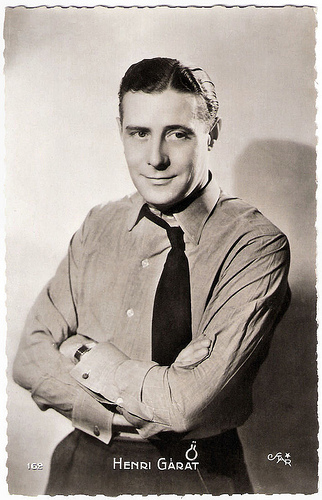
French postcard by Editions P.I., no. 162. Photo: Star.
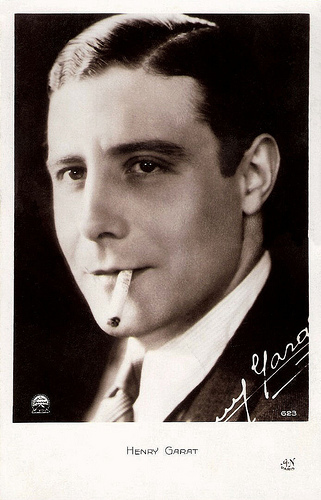
French postcard by AN, Paris, no. 623. Photo: Paramount.
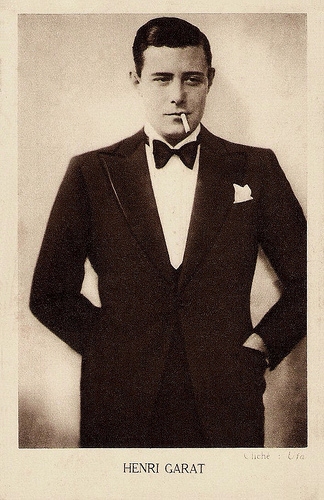
Dutch postcard by De Faam, Breda. Sent by mail in the Netherlands in 1932. Photo: Ufa.
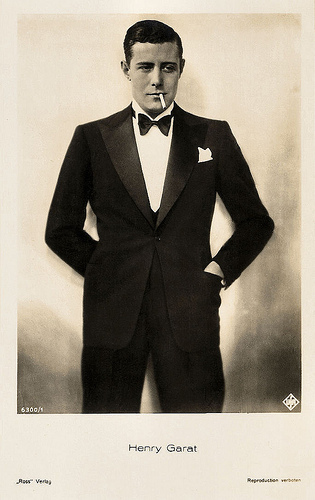
German postcard by Ross Verlag, no. 6300/1, 1931-1932. Photo: Ufa.
Jeune Premier
Henri (sometimes Henry) Garat was born Emile Henri Camille Garassu in Paris in 1902. He was the son of a minor actor and vaudeville performer known as Garet and the singer Césarine Lévy.
Henri began his career in 1924 as a jeune premier in music halls working with the likes of Mistinguett. In 1930 he made his first film for the Ufa, Flagrant délit/Burglars (Hanns Schwarz, Georges Tréville, 1930) starring Blanche Montel .
He replaced Willy Fritsch in the French adaptation of the popular German film operetta Die Drei von der Tankstelle (1930) starring Lilian Harvey and the result, Le chemin du Paradis/The Road to Paradise (Wilhelm Thiele, Max de Vaucorbeil, 1930) was a huge success and made Garat a 'grand vedette' in France.
He replaced Fritsch again in the French but also in the English versions of Der Kongress Tanzt (1931): Le congrès s'amuse (Erik Charell, Jean Boyer, 1931) and Congress Dances (Erik Charell, Jean Boyer, 1931), both with Lilian Harvey .
Other films with Harvey were La fille et le garçon/The Girl and the Boy (Roger Le Bon, Wilhelm Thiele, 1931), Princesse, à vos ordres/Adorable (Hanns Schwarz, Max de Vaucorbeil, 1931) and Un rêve blond/Happy Ever After (André Daven, Paul Martin, 1932) based on a script by Walter Reisch and Billy Wilder. His songs in these films became huge hits.
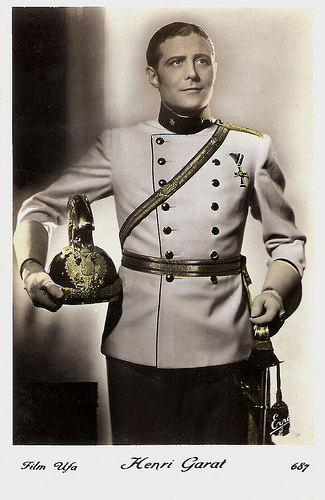
French postcard by Erpé, no. 779. Photo: Ufa.
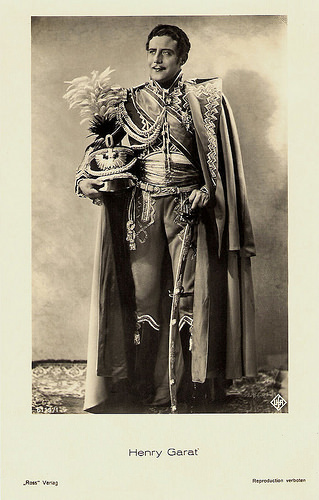
German postcard by Ross Verlag, no. 6119/1, 1931-1932. Photo: Ufa. Publicity still for Le congrès s'amuse (Jean Boyer, Erik Charell, 1931).
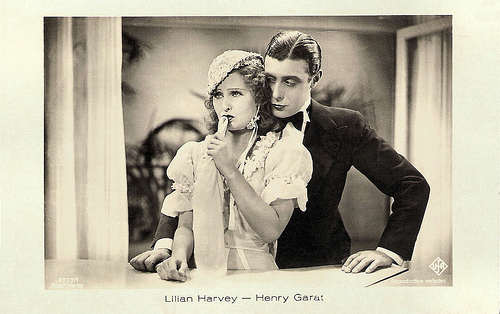
With Lilian Harvey . German postcard by Ross Verlag, no. 6739/1, 1931-1932. Photo: Ufa. Publicity still for Le Chemin du Paradis/The Road to Paradise (Wilhelm Thiele, Max de Vaucorbeil, 1930).
![Lilian Harvey and Henry [Henri] Garat in Princesse, à vos ordres](https://i.gr-assets.com/images/S/compressed.photo.goodreads.com/hostedimages/1453115877i/17782200.jpg)
Belgian postcard by Edition de la Chocolaterie Lecoq, no. 59. Photo: Ufa. Caption: " Lilian Harvey and Henry Garat in the famous film Princesse à vos ordres." Princesse à vos ordres (Hanns Schwarz, Max de Vaucorbeil, 1931) was the French version of the early German sound film Ihre Hoheit befiehlt. Co-writer of this film was Billy Wilder. It was remade in Hollywood in 1933 as Adorable, with Garat and Janet Gaynor.
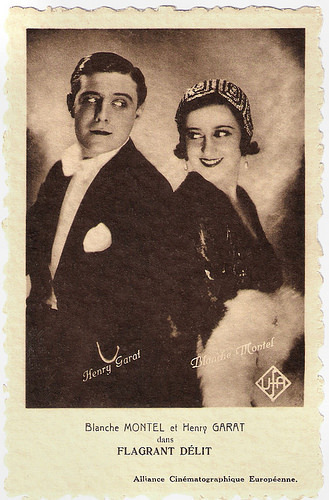
French postcard by Nels / Alliance Cinématographiques Européenne. Photo: Ufa. Publicity still for Flagrant Délit (Hanns Schwarz, Georges Tréville, 1931) with Blanche Montel . Flagrant Délit was an alternate-language version of Einbrecher/Burglars (Hanns Schwarz, 1930) with Lilian Harvey and Willy Fritsch .
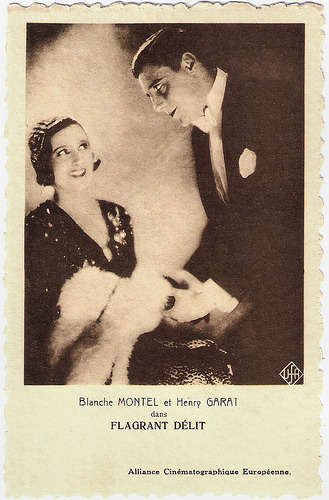
French postcard by Nels / Alliance Cinématographiques Européenne. Photo: Ufa. Publicity still for Flagrant Délit (Hanns Schwarz, Georges Tréville, 1931) with Blanche Montel .
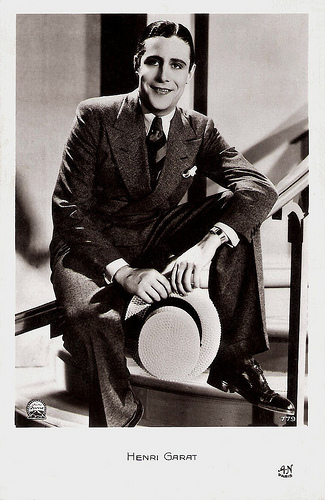
French postcard by A.N., Paris, no. 779. Photo: Paramount. Publicity still for Delphine (Roger Capellani, 1931).
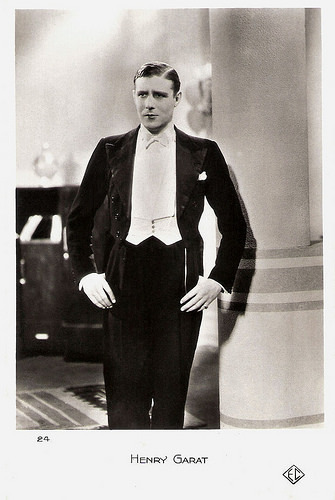
French postcard by Editions Chantal (EC), Paris, no. 24. Publicity still for Un soir de réveillon/Christmas Eve (Karl Anton, 1933).
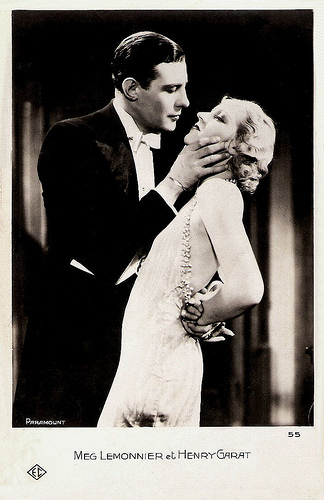
French postcard by Éditions Chantal (EC), Paris, no. 55. Photo: Paramount. Publicity still for Un soir de réveillon/Christmas Eve (Karl Anton, 1933) with Meg Lemonnier.
Seducer
When Lilian Harvey left for Hollywood Henri Garat continued with a new partner, Meg Lemonnier , in Simone est comme ça/Simone Is Like That (Karl Anton, 1932), which became his biggest success.
He starred with Arletty in his best film, Un soir de réveillon/Christmas Eve (Karl Anton, 1933). In Hollywood he appeared with Janet Gaynor in Adorable (William Dieterle, 1933), a remake of Princesse, à vos ordres.
He returned to Paris for the Molière adaptation Les dieux s'amusent/Amphitryon (Reinhold Schünzel, Albert Valentin, 1935). In 1936 he made another comedy with Lilian Harvey , Les gais lurons/Lucky Kids (Paul Martin, Jacques Natanson, 1936), but his next films were less popular than they used to be.
At the end of the 1930s Garat started to consummate cocaine and his career declined further. His extravagances (a yacht, an aeroplane, a castle) and his divorces ruined him. His next films failed and he suffered a serious depression. In 1944 he left for Switzerland for a long period of rehab.
In 1947 he tried to make a come-back to no avail and also in the 1950s he tried several times to return in the spotlights, but sadly nobody was interested anymore in the former jeune premier. Henri Garat died in 1959 in Hyères, France, at the age of 57. He had been married four times. His wives were Betty Rowe, Marie Tchernycheff, Jacqueline Nigon, and Anna Luginbuhl. With Luginbuhl he had a son.
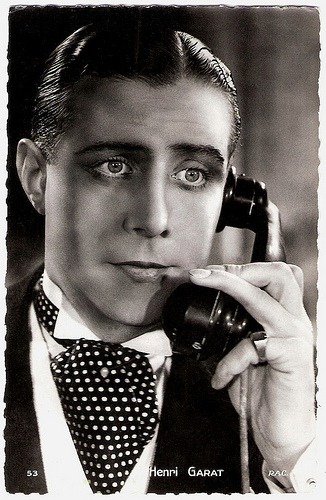
French postcard by Editions Chantal, Rueil, no. 53. Photo: R.A.C.
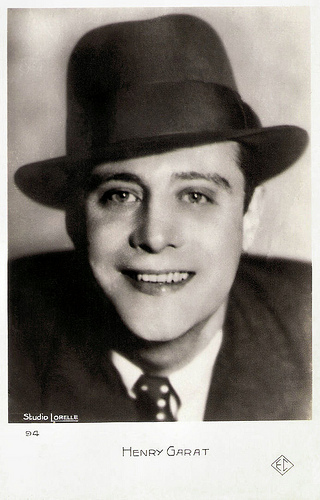
French postcard by Editions Chantal (EC), Paris, no. 94. Photo: Studio Lorelle.
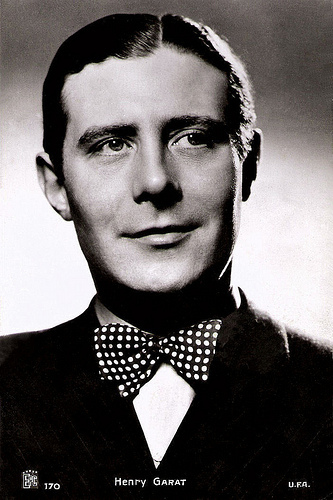
French postcard by EPC (Editions et Publications Cinematographiques), no. 170. Photo: Ufa.
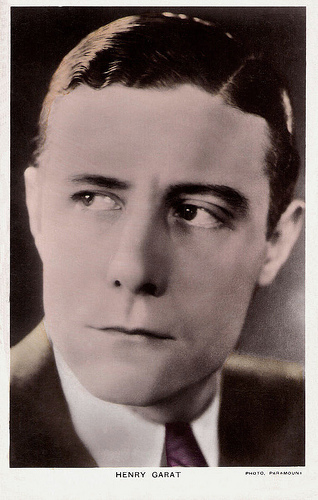
British postcard in the Colourgraph Series, London, no. C 153. Photo: Paramount.
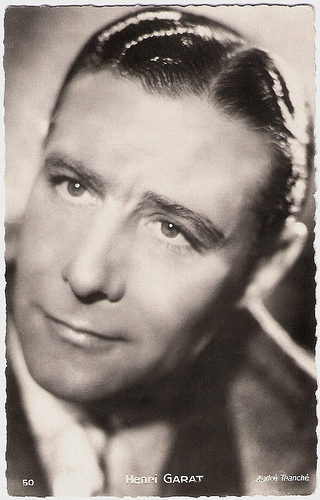
French postcard by Editions E.C., Paris, no. 50. Photo: André Tranché.
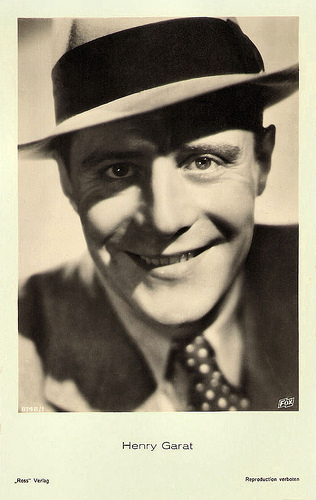
German postcard by Ross Verlag, no. 8748/1, 1933-1934. Photo: Fox.
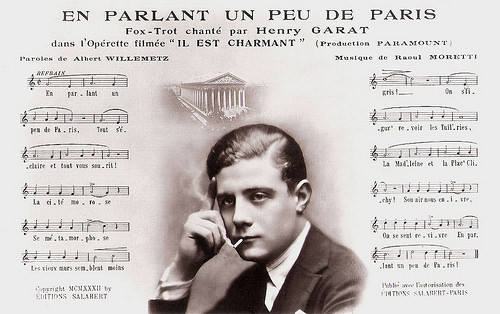
French postcard by P.C., Paris, no. 1. Photo: Paramount. Publicity still for Il est charmant/He Is Charming (Louis Mercanton, 1932). Music sheet for the song En parlant un peu de Paris.
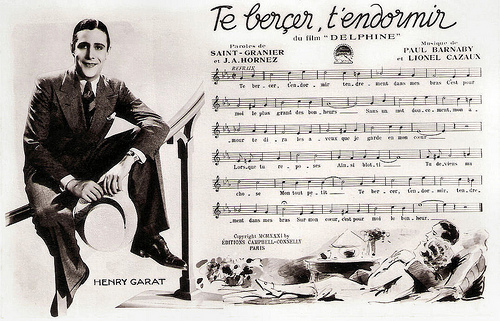
French postcard by P.C., Paris, no. 50. Photo and song from Delphine (Roger Capellani, 1931).
Clip from Un soir de réveillon (Karl Anton, 1933). Henri Garat sings J'aime les femmes (I Love Women). Source: Vieux Disques (YouTube).
Sources: Charlotte Hanotte (CinéArtistes, French), Paul Dubé, Jacques Marchioro (Du Temps des cerises aux Feuilles mortes, in French), Hall de la Chanson (French), Wikipedia and .

French postcard by Viny, no. 68. Photo: Star.

French postcard by Viny, no. 68. Photo: Star.

French postcard by Editions P.I., no. 162. Photo: Star.

French postcard by AN, Paris, no. 623. Photo: Paramount.

Dutch postcard by De Faam, Breda. Sent by mail in the Netherlands in 1932. Photo: Ufa.

German postcard by Ross Verlag, no. 6300/1, 1931-1932. Photo: Ufa.
Jeune Premier
Henri (sometimes Henry) Garat was born Emile Henri Camille Garassu in Paris in 1902. He was the son of a minor actor and vaudeville performer known as Garet and the singer Césarine Lévy.
Henri began his career in 1924 as a jeune premier in music halls working with the likes of Mistinguett. In 1930 he made his first film for the Ufa, Flagrant délit/Burglars (Hanns Schwarz, Georges Tréville, 1930) starring Blanche Montel .
He replaced Willy Fritsch in the French adaptation of the popular German film operetta Die Drei von der Tankstelle (1930) starring Lilian Harvey and the result, Le chemin du Paradis/The Road to Paradise (Wilhelm Thiele, Max de Vaucorbeil, 1930) was a huge success and made Garat a 'grand vedette' in France.
He replaced Fritsch again in the French but also in the English versions of Der Kongress Tanzt (1931): Le congrès s'amuse (Erik Charell, Jean Boyer, 1931) and Congress Dances (Erik Charell, Jean Boyer, 1931), both with Lilian Harvey .
Other films with Harvey were La fille et le garçon/The Girl and the Boy (Roger Le Bon, Wilhelm Thiele, 1931), Princesse, à vos ordres/Adorable (Hanns Schwarz, Max de Vaucorbeil, 1931) and Un rêve blond/Happy Ever After (André Daven, Paul Martin, 1932) based on a script by Walter Reisch and Billy Wilder. His songs in these films became huge hits.

French postcard by Erpé, no. 779. Photo: Ufa.

German postcard by Ross Verlag, no. 6119/1, 1931-1932. Photo: Ufa. Publicity still for Le congrès s'amuse (Jean Boyer, Erik Charell, 1931).

With Lilian Harvey . German postcard by Ross Verlag, no. 6739/1, 1931-1932. Photo: Ufa. Publicity still for Le Chemin du Paradis/The Road to Paradise (Wilhelm Thiele, Max de Vaucorbeil, 1930).
![Lilian Harvey and Henry [Henri] Garat in Princesse, à vos ordres](https://i.gr-assets.com/images/S/compressed.photo.goodreads.com/hostedimages/1453115877i/17782200.jpg)
Belgian postcard by Edition de la Chocolaterie Lecoq, no. 59. Photo: Ufa. Caption: " Lilian Harvey and Henry Garat in the famous film Princesse à vos ordres." Princesse à vos ordres (Hanns Schwarz, Max de Vaucorbeil, 1931) was the French version of the early German sound film Ihre Hoheit befiehlt. Co-writer of this film was Billy Wilder. It was remade in Hollywood in 1933 as Adorable, with Garat and Janet Gaynor.

French postcard by Nels / Alliance Cinématographiques Européenne. Photo: Ufa. Publicity still for Flagrant Délit (Hanns Schwarz, Georges Tréville, 1931) with Blanche Montel . Flagrant Délit was an alternate-language version of Einbrecher/Burglars (Hanns Schwarz, 1930) with Lilian Harvey and Willy Fritsch .

French postcard by Nels / Alliance Cinématographiques Européenne. Photo: Ufa. Publicity still for Flagrant Délit (Hanns Schwarz, Georges Tréville, 1931) with Blanche Montel .

French postcard by A.N., Paris, no. 779. Photo: Paramount. Publicity still for Delphine (Roger Capellani, 1931).

French postcard by Editions Chantal (EC), Paris, no. 24. Publicity still for Un soir de réveillon/Christmas Eve (Karl Anton, 1933).

French postcard by Éditions Chantal (EC), Paris, no. 55. Photo: Paramount. Publicity still for Un soir de réveillon/Christmas Eve (Karl Anton, 1933) with Meg Lemonnier.
Seducer
When Lilian Harvey left for Hollywood Henri Garat continued with a new partner, Meg Lemonnier , in Simone est comme ça/Simone Is Like That (Karl Anton, 1932), which became his biggest success.
He starred with Arletty in his best film, Un soir de réveillon/Christmas Eve (Karl Anton, 1933). In Hollywood he appeared with Janet Gaynor in Adorable (William Dieterle, 1933), a remake of Princesse, à vos ordres.
He returned to Paris for the Molière adaptation Les dieux s'amusent/Amphitryon (Reinhold Schünzel, Albert Valentin, 1935). In 1936 he made another comedy with Lilian Harvey , Les gais lurons/Lucky Kids (Paul Martin, Jacques Natanson, 1936), but his next films were less popular than they used to be.
At the end of the 1930s Garat started to consummate cocaine and his career declined further. His extravagances (a yacht, an aeroplane, a castle) and his divorces ruined him. His next films failed and he suffered a serious depression. In 1944 he left for Switzerland for a long period of rehab.
In 1947 he tried to make a come-back to no avail and also in the 1950s he tried several times to return in the spotlights, but sadly nobody was interested anymore in the former jeune premier. Henri Garat died in 1959 in Hyères, France, at the age of 57. He had been married four times. His wives were Betty Rowe, Marie Tchernycheff, Jacqueline Nigon, and Anna Luginbuhl. With Luginbuhl he had a son.

French postcard by Editions Chantal, Rueil, no. 53. Photo: R.A.C.

French postcard by Editions Chantal (EC), Paris, no. 94. Photo: Studio Lorelle.

French postcard by EPC (Editions et Publications Cinematographiques), no. 170. Photo: Ufa.

British postcard in the Colourgraph Series, London, no. C 153. Photo: Paramount.

French postcard by Editions E.C., Paris, no. 50. Photo: André Tranché.

German postcard by Ross Verlag, no. 8748/1, 1933-1934. Photo: Fox.

French postcard by P.C., Paris, no. 1. Photo: Paramount. Publicity still for Il est charmant/He Is Charming (Louis Mercanton, 1932). Music sheet for the song En parlant un peu de Paris.

French postcard by P.C., Paris, no. 50. Photo and song from Delphine (Roger Capellani, 1931).
Clip from Un soir de réveillon (Karl Anton, 1933). Henri Garat sings J'aime les femmes (I Love Women). Source: Vieux Disques (YouTube).
Sources: Charlotte Hanotte (CinéArtistes, French), Paul Dubé, Jacques Marchioro (Du Temps des cerises aux Feuilles mortes, in French), Hall de la Chanson (French), Wikipedia and .
Published on January 17, 2016 22:00
January 16, 2016
Eva Moore
English actress Eva Moore (1870–1955) had a career on stage and in film which spanned six decades. She was active in the women's suffrage movement, and from 1920 on she appeared in over two dozen films.
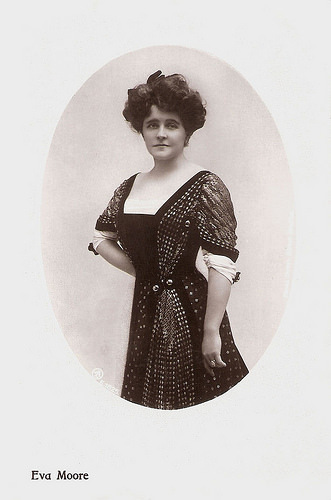
British postcard in the Satinetti Series by Aristophot. Co. Ltd, London.
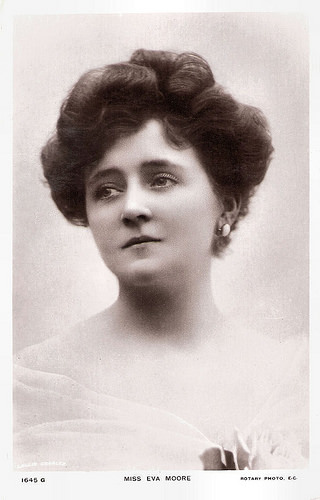
British postcard in the Rotary Photographic Series, no. 1645 G. Photo: Lallie Charles.
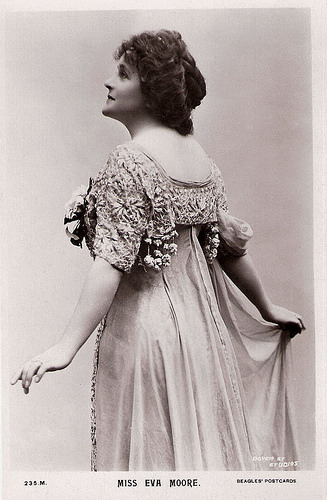
British postcard by Beagles' Postcards, no. 235 M. Photo: Dover St. Studios.
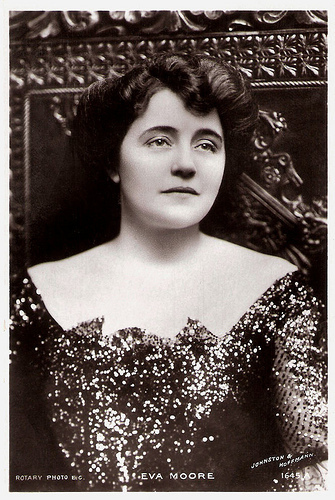
British postcard by Rotary Photo. Photo: Johnston & Hoffmann.
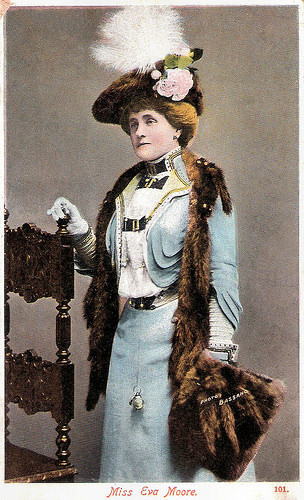
British postcard in the Ducal Series, no. 101. Photo: Bassano.
Olivier´s Mom-in-Law
Eva Moore was born in Brighton, England in 1870. She was the daughter of Edmund Henry Moore by his spouse Emily née Strachan. Her sister was the actress Decima Moore.
Eva made her first stage appearance at London's Vaudeville Theatre in 1887, as Varney in Proposals. She next joined Toole's company.
In 1891 she married the actor Henry V. Esmond. They had two children, race car driver Jack Esmond and actress Jill Esmond, the first wife of Laurence Olivier.
In 1892, Eva appeared as Minestra in The Mountebanks by W. S. Gilbert and Alfred Cellier. In 1894, she joined Charles Hawtrey and Lottie Venne in F. C. Burnand's A Gay Widow. Other stage roles included Mabel Vaughn in The Wilderness (1901); Lady Ernestone in Esmond's My Lady Cirtue and Wilhelmina Marr in his Billy's Little Love Affair (both in 1903); and Kathie in Old Heidelberg (1902 and 1909) with George Alexander .
In 1907 she took the name part in Sweet Kitty Bellaire (1907); and she played Mrs. Errol in Little Lord Fauntleroy and Mrs. Crowley in The Explorer in 1908, and the Hon. Mrs. Bayle in Best People and the Hon. Mrs. Rivers in The House Opposite in 1909. She later managed the Henry V. Esmond comedy Eliza Comes to Stay, which opened at the Criterion Theatre in 1913, transferring to the Vaudeville in 1914.
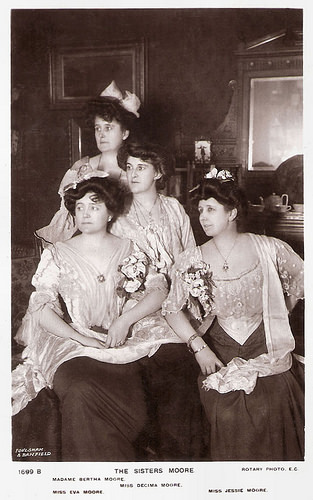
Decima, Bertha, Eva and Jessie Moore. British postcard in the Rotary Photographic Series, no. 1699 B. Photo: Foulsham & Banfield.
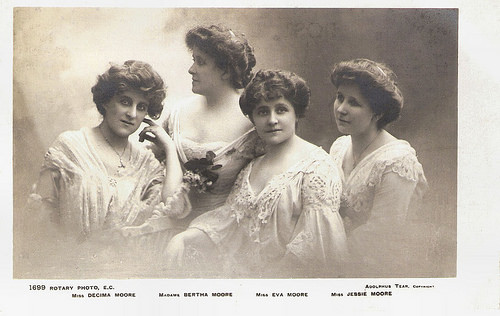
Decima, Bertha, Eva and Jessie Moore. British postcard in the Rotary Photographic Series, no. 1699. Photo: Adolphus Tear.
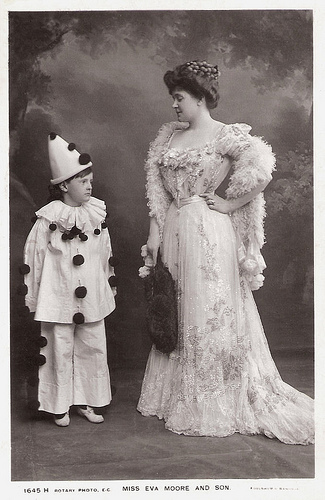
British postcard in the Rotary Photographic Series, no. 1645 H. Photo: Foulsham & Banfield. Eva Moore's son later became race car driver Jack Esmond.
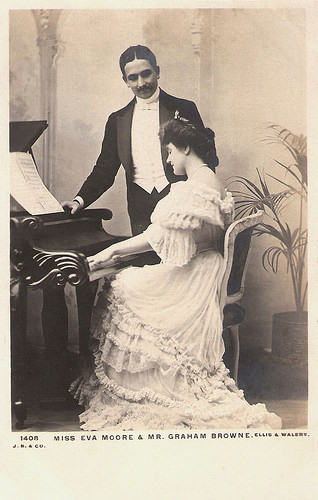
Eva Moore and Graham Browne. British postcard by J.Beagles & Co., London, no. 1408. Photo: Ellis & Walery.
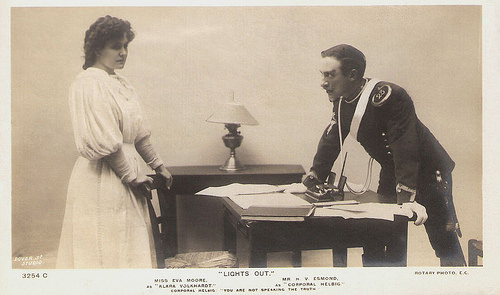
British postcard in the Rotary Photographic Series, no. 3254 C. Photo: Dover St. Studio. Publicity still for the stage play Lights Out (1905-1906) with Eva Moore as Klara Volkhardt and Henry V. Esmond (Eva Moore's husband) as Corporal Helbig. Corporal Helbig: "You are not speaking the truth".
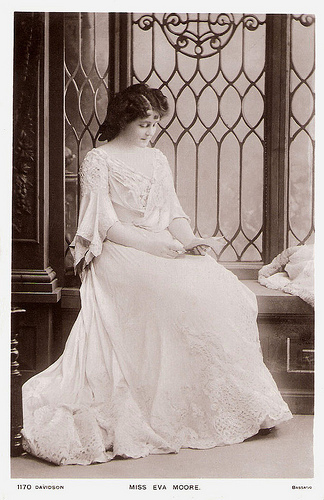
British postcard by Davidson Bros. in the Glossyphoto series, no. 1170. Sent by mail in 1905. Photo: Bassano.
Suffragette
After World War I broke out, Eva Moore continued acting at the Vaudeville in the evenings but worked as a volunteer for the Women's Emergency Corps, based at the Little Theatre, during the day. In October 1920, she and Esmond toured Canada with Nigel Bruce as their stage manager, who also played Montague Jordan in Eliza Comes to Stay, which re-opened at the Duke of York's Theatre in London on 14 June 1923. Moore was active in the suffrage movement (as was her sister Decima), attending meetings and appearing in suffragist plays and films.
From 1920 to 1946, she made over two dozen films, beginning with The Law Divine (H.B. Parkinson, Challis Sanderson, 1920), co-starring with her husband Henry V. Esmond. Some of her best-received silent films were The Crimson Circle (George Ridgwell, 1922), Chu-Chin-Chow (Herbert Wilcox, 1923) starring Betty Blythe, The Great Well (Henry Kolker, 1924) and the war drama Motherland (G.B. Samuelson, 1927).
As a trained stage actress she had had no problems with the transition to the sound film era. Her most popular British ‘talkies’ included Almost a Divorce (Jack Raymond, Arthur Varney, 1931), I Was a Spy (Victor Saville, 1933) starring Madeleine Carroll , Jew Süss (Lothar Mendes, 1934) with Conrad Veidt , and The Divorce of Lady X (Tim Whelan, 1938), which starred her son-in-law Laurence Olivier.
In Hollywood she appeared with Charles Laughton and Boris Karloff in the classic horror film The Old Dark House (James Whale, 1932). Later films were the Hollywood production Of Human Bondage (Edmund Goulding, 1946) starring Paul Henreid, and her final film A Son Is Born (Eric Porter, 1946) with Peter Finch.
She published her reminiscences under the title of Exits and Entrances. Eva Moore died in 1955 in Maidenhead, England, aged 85. Her grandson is producer-director Tarquin Olivier.
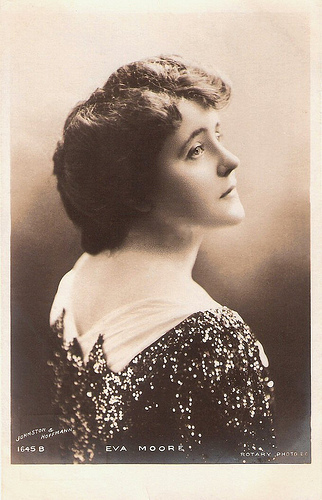
British postcard in the Rotary Photographic series, no. 1645 B. Photo: Johnston & Hoffmann.
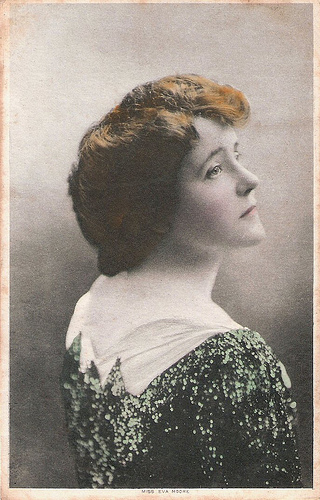
British postcard. Sent by mail in 1904. Photo: Johnston & Hoffmann.
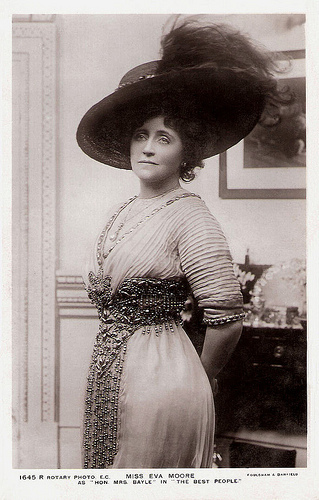
British postcard by Rotary Photo, no. 1645 R. Photo: Foylman & Banfield. Publicity still for the stage play The Best People.
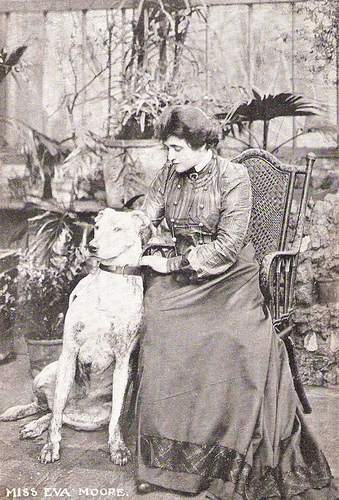
British postcard in the Yes of No? series. Sent by mail in 1904.
Clip from The Old Dark House (1932) with Gloria Stuart. Source: Evan Johnson (YouTube).
Sources: Thomas Staedeli (Cyranos), Wikipedia and .

British postcard in the Satinetti Series by Aristophot. Co. Ltd, London.

British postcard in the Rotary Photographic Series, no. 1645 G. Photo: Lallie Charles.

British postcard by Beagles' Postcards, no. 235 M. Photo: Dover St. Studios.

British postcard by Rotary Photo. Photo: Johnston & Hoffmann.

British postcard in the Ducal Series, no. 101. Photo: Bassano.
Olivier´s Mom-in-Law
Eva Moore was born in Brighton, England in 1870. She was the daughter of Edmund Henry Moore by his spouse Emily née Strachan. Her sister was the actress Decima Moore.
Eva made her first stage appearance at London's Vaudeville Theatre in 1887, as Varney in Proposals. She next joined Toole's company.
In 1891 she married the actor Henry V. Esmond. They had two children, race car driver Jack Esmond and actress Jill Esmond, the first wife of Laurence Olivier.
In 1892, Eva appeared as Minestra in The Mountebanks by W. S. Gilbert and Alfred Cellier. In 1894, she joined Charles Hawtrey and Lottie Venne in F. C. Burnand's A Gay Widow. Other stage roles included Mabel Vaughn in The Wilderness (1901); Lady Ernestone in Esmond's My Lady Cirtue and Wilhelmina Marr in his Billy's Little Love Affair (both in 1903); and Kathie in Old Heidelberg (1902 and 1909) with George Alexander .
In 1907 she took the name part in Sweet Kitty Bellaire (1907); and she played Mrs. Errol in Little Lord Fauntleroy and Mrs. Crowley in The Explorer in 1908, and the Hon. Mrs. Bayle in Best People and the Hon. Mrs. Rivers in The House Opposite in 1909. She later managed the Henry V. Esmond comedy Eliza Comes to Stay, which opened at the Criterion Theatre in 1913, transferring to the Vaudeville in 1914.

Decima, Bertha, Eva and Jessie Moore. British postcard in the Rotary Photographic Series, no. 1699 B. Photo: Foulsham & Banfield.

Decima, Bertha, Eva and Jessie Moore. British postcard in the Rotary Photographic Series, no. 1699. Photo: Adolphus Tear.

British postcard in the Rotary Photographic Series, no. 1645 H. Photo: Foulsham & Banfield. Eva Moore's son later became race car driver Jack Esmond.

Eva Moore and Graham Browne. British postcard by J.Beagles & Co., London, no. 1408. Photo: Ellis & Walery.

British postcard in the Rotary Photographic Series, no. 3254 C. Photo: Dover St. Studio. Publicity still for the stage play Lights Out (1905-1906) with Eva Moore as Klara Volkhardt and Henry V. Esmond (Eva Moore's husband) as Corporal Helbig. Corporal Helbig: "You are not speaking the truth".

British postcard by Davidson Bros. in the Glossyphoto series, no. 1170. Sent by mail in 1905. Photo: Bassano.
Suffragette
After World War I broke out, Eva Moore continued acting at the Vaudeville in the evenings but worked as a volunteer for the Women's Emergency Corps, based at the Little Theatre, during the day. In October 1920, she and Esmond toured Canada with Nigel Bruce as their stage manager, who also played Montague Jordan in Eliza Comes to Stay, which re-opened at the Duke of York's Theatre in London on 14 June 1923. Moore was active in the suffrage movement (as was her sister Decima), attending meetings and appearing in suffragist plays and films.
From 1920 to 1946, she made over two dozen films, beginning with The Law Divine (H.B. Parkinson, Challis Sanderson, 1920), co-starring with her husband Henry V. Esmond. Some of her best-received silent films were The Crimson Circle (George Ridgwell, 1922), Chu-Chin-Chow (Herbert Wilcox, 1923) starring Betty Blythe, The Great Well (Henry Kolker, 1924) and the war drama Motherland (G.B. Samuelson, 1927).
As a trained stage actress she had had no problems with the transition to the sound film era. Her most popular British ‘talkies’ included Almost a Divorce (Jack Raymond, Arthur Varney, 1931), I Was a Spy (Victor Saville, 1933) starring Madeleine Carroll , Jew Süss (Lothar Mendes, 1934) with Conrad Veidt , and The Divorce of Lady X (Tim Whelan, 1938), which starred her son-in-law Laurence Olivier.
In Hollywood she appeared with Charles Laughton and Boris Karloff in the classic horror film The Old Dark House (James Whale, 1932). Later films were the Hollywood production Of Human Bondage (Edmund Goulding, 1946) starring Paul Henreid, and her final film A Son Is Born (Eric Porter, 1946) with Peter Finch.
She published her reminiscences under the title of Exits and Entrances. Eva Moore died in 1955 in Maidenhead, England, aged 85. Her grandson is producer-director Tarquin Olivier.

British postcard in the Rotary Photographic series, no. 1645 B. Photo: Johnston & Hoffmann.

British postcard. Sent by mail in 1904. Photo: Johnston & Hoffmann.

British postcard by Rotary Photo, no. 1645 R. Photo: Foylman & Banfield. Publicity still for the stage play The Best People.

British postcard in the Yes of No? series. Sent by mail in 1904.
Clip from The Old Dark House (1932) with Gloria Stuart. Source: Evan Johnson (YouTube).
Sources: Thomas Staedeli (Cyranos), Wikipedia and .
Published on January 16, 2016 22:00
January 15, 2016
Jorge Mistral
Handsome and talented actor Jorge Mistral (1920-1972) became a star in Spanish films during the 1940s. In the 1950s, he lived and worked in México and appeared in Luis Buñuel's Abismos de pasión/Wuthering Heights (1954). Later, in the 1960s, he directed three films.
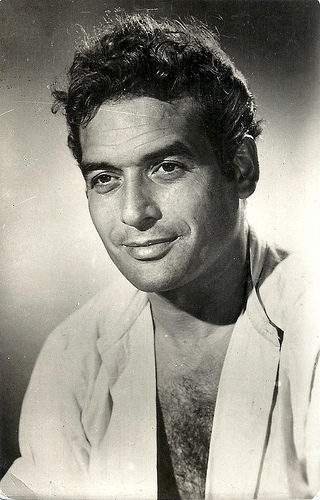
Spanish postcard, no. 2714.
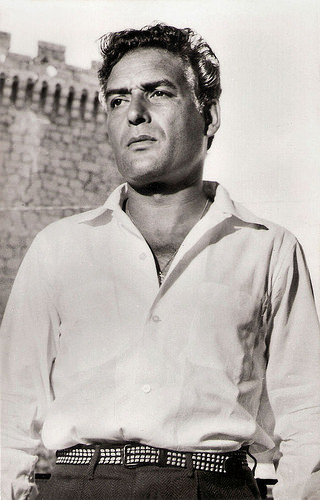
Spanish postcard by Soberanas, Barna, no. 263.
Look handsome and be sympathetic
Jorge Mistral was born Modesto Llosas Rosell in 1920 in Aldaya, Spain. His father was from Puerto Rico and his mother from Catalonia. Since childhood Jorge was interested in artistic activities. In 1943, he abandoned his law studies and began to work in the theatre company of Enrique Borrás, at the time one of the most prestigious Spanish-speaking actors.
A year later he made his film debut in La llamada del mar/Call of the Sea (José Gaspar, 1944). The film nor his performance impressed anyone. The next years he studied alongside renowned actors, and his talent and good looks lead him to success.
Mistral became a star in films produced by Spain's largest studio Cifesa. His breakthrough was Misión blanca/White Mission (Juan de Orduña, 1946) in which he co-starred with Manuel Luna and Fernando Rey. The film, about a religious mission in the Spanish Empire was shot on location in Spanish Guinea and in a Spanish studio.
In 1948 he appeared the historical drama in Locura de amor/Madness for Love (Juan de Orduña, 1948) with Aurora Batista, Fernando Rey and Sara Montiel . The film tells the story of Queen Joanna of Castile (Batista), known as ‘Juana la loca’, and her husband Philip I of Castile (Rey), also known as ‘Philip the handsome’.
At IMDb , Ignacio Martinez-Ybor reviews: “This movie was part of a propaganda effort of the Franco regime to extol the ‘traditional’ values of the ‘true’ Spain ..... by true is meant nationalistic, non-foreign characters in the plot, the archvillains being the Flemish allies of the King and the moorish girl played by a very young Sarita Montiel . (…) As merely a movie, Locura de Amor is quite engaging, in a compressed telenovela sort of way (…) Jorge Mistral played handsomely and sympathetically a part which required him to look handsome and be sympathetic.”
The following year he made the drama Currito de la Cruz/Currito of the Cross (Luis Lucia, 1949) starring Pepín Martín Vázquez, and the expensive costume drama La duquesa de Benamejí/The Duchess of Benameji (Luis Lucia, 1949) starring Amparo Rivelles in dual roles as a countess and a gypsy. In the comedy La hermana San Sulpicio/Sister San Sulpicio (Luis Lucia, 1952) and the musical Un caballero andaluz/An Andalusian Gentleman (Luis Lucia, 1954), he co-starred with Carmen Sevilla .
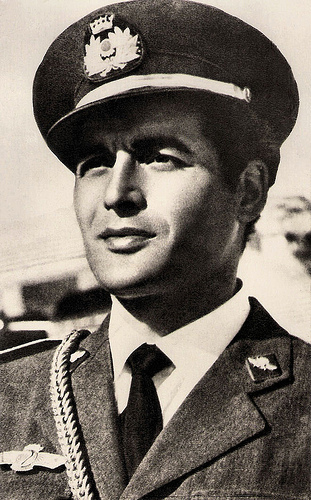
Spanish postcard by J.R., B. Photo: publicity still for La trinca del aire/Lashing the air (Ramón Torrado, 1951).
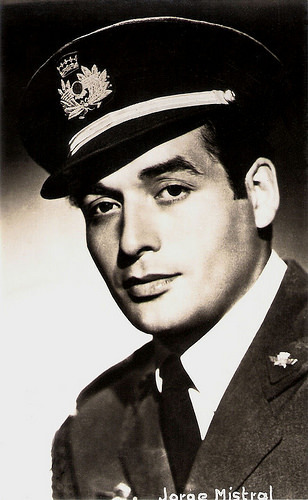
Spanish postcard by Marte. Photo: publicity still for La trinca del aire/Lashing the air (Ramón Torrado, 1951).
International scandal
From the 1950s on, Jorge Mistral also worked in Cuba and Argentine. Later he often worked México, which became his second homeland. There, Mistral achieved enormous popularity opposite Gloria Marin in the classic tearjerker El derecho de nacer/The right to be born (Zacarías Gómez Urquiza, 1952), an unprecedented blockbuster in Mexico.
One of his best known Mexican films is Luis Buñuel's Abismos de pasión/Wuthering Heights (1953), based on the Emily Brontë novel Wuthering Heights. The film starred Irasema Dilián and Mistral as the Cathy and Heathcliff characters.
Gabriela Zayas at IMDb : “Buñuel's genius operates the miracle, aided by his excellent cast and team. This is the one version that captures the roots of Cathy's and Heathcliff's deep and contradictory emotions, the passions, the love and hate they shared and suffered, being all of them doomed to be unhappy in this world and hoping to be redeemed and united in the other. Placed in Mexico, black and white excellent photography, with a believable and intense cast, and a passionate, yet sometimes ironic direction.”
Mistral continued to star in European films like Italian-Spanish film noir Il mondo sarà nostro/Andalusia Express (Francisco Rovira Beleta, 1956), also with Vincente Parra and Mara Berni, and the Italian religious drama La spada e la croce/The Sword and the Cross (Carlo Ludovico Bragaglia, 1958) with Hollywood star Yvonne De Carlo as Mary Magdelene.
Mistral had a supporting part as the lazy fisherman lover of Sophia Loren in the Hollywood production Boy on a Dolphin (Jean Negulesco, 1957), set in Greece. The romantic film is noteworthy as Loren's English language debut, and also starred Alan Ladd and Clifton Webb.
Mistral also appeared opposite Zully Moreno in the Argentine romantic drama Amor prohibido/Prohibited Love (Luis César Amadori, 1958) based on Anna Karenina by Leo Tolstoy.
In Spain he starred in La venganza/Vengeance (Juan Antonio Bardem, 1958) with Carmen Sevilla and Raf Vallone . La venganza was shown at the 1958 Cannes Film Festival and was nominated for the Academy Award for Best Foreign Language Film. But the film was not released in Spain under General Franco until the following year and had serious troubles with the fascist censorship. Director Bardem even went to prison which caused an international scandal.
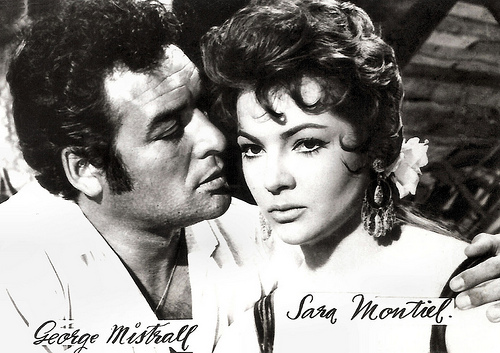
Romanian collectors card. Publicity still for Carmen de la Ronda/A Girl Against Napoleon (Tulio Demicheli, 1959) with Sara Montiel .
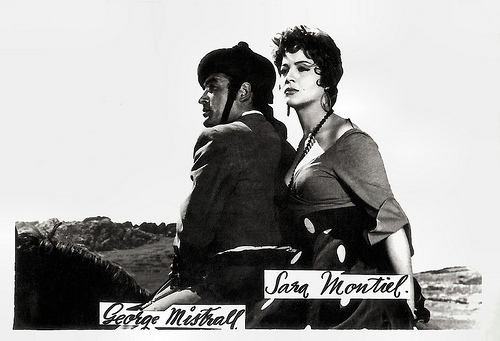
Romanian collectors card. Publicity still for Carmen de la Ronda/A Girl Against Napoleon (Tulio Demicheli, 1959) with Sara Montiel.
Suicide with a gunshot
Jorge Mistral co-starred with Sara Montiel and Maurice Ronet in the Spanish historical adventure film Carmen la de Ronda/A Girl Against Napoleon (Tulio Demicheli, 1959). The film was loosely based on the story of Prosper Mérimée's Carmen, with the setting changed to the Peninsular War era. Carmen is here involved with the Guerilla's fighting against the French occupation.
During the 1960s, Mistral’s film parts became smaller. He played a supporting part in the Mexican drama Juana Gallo (Miguel Zacarías, 1961), which was entered into the 2nd Moscow International Film Festival. In Argentine he appeared in the drama Bajo un mismo rostro/Under the Same Skin (Daniel Tinayre, 1962).
In France he played the Grand Vizir Zaccar in Shéhérazade (Pierre Gaspard-Huit, 1963) starring Anna Karina. He also appeared in the Eurowestern Los Pistoleros de Casa Grande/Gunfighters of Casa Grande (Roy Rowland, 1964), co-produced by American and Spanish producers and starring Alex Nicol.
Jorge Mistral also directed three films, La Piel desnuda/The bare skin (1966) with Marta Romero, La Fiebre del deseo/The fever of desire (1966) with Kitty de Hoyos, and Crimen sin olvido/Crime without oblivion (1968) starring Rosángela Balbó. The latter was never released.
Although he kept playing in films and TV series, his efforts were less prominent than in the 1940s and 1950s. His final film appearance was a small part in the Mexican crime-comedy Diamantes, oro, y amor/Diamonds, gold and love (Juan Manuel Torres, 1973).
Mistral married three times. In Argentine he married Olga Marchetti, with whom he had a daughter who died a few days after her birth. He also married Cristina Ruiz Cano and Graciela Dufau, but all his marriages ended in a divorce.
In 1972, Jorge Mistral committed suicide with a gunshot. He was only 51, when he died in Mexico City.
In his blog El Lado Oscuro de Hollywood, Jesús Iglesias Lerroux notes that just a few days before his death Mistral had served as a reciter in several nightclubs in Mexico City. The critics and audiences applauded him in his new role, but Mistral had only done it for the money. Debt-ridden, prematurely old-looking, ill and alone, Mistral had not considered his life worth to live any longer. His death was deeply felt in the Spanish-speaking countries.
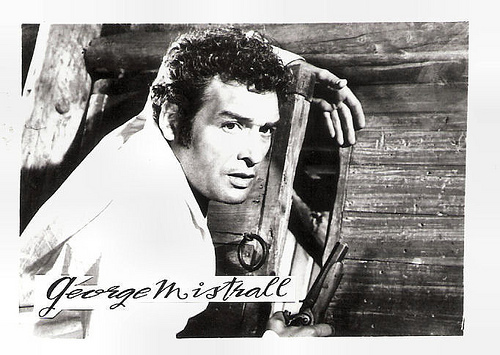
Romanian collectors card.
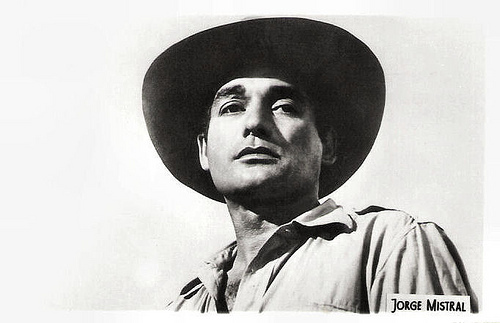
Romanian collectors card.
American trailer for Abismos de pasión/Wuthering Heights (Luis Buñuel, 1953). Source: Video Detective (YouTube).
Sources: Jesús Iglesias Lerroux (El Lado Oscuro de Hollywood - Spanish), Wikipedia and .

Spanish postcard, no. 2714.

Spanish postcard by Soberanas, Barna, no. 263.
Look handsome and be sympathetic
Jorge Mistral was born Modesto Llosas Rosell in 1920 in Aldaya, Spain. His father was from Puerto Rico and his mother from Catalonia. Since childhood Jorge was interested in artistic activities. In 1943, he abandoned his law studies and began to work in the theatre company of Enrique Borrás, at the time one of the most prestigious Spanish-speaking actors.
A year later he made his film debut in La llamada del mar/Call of the Sea (José Gaspar, 1944). The film nor his performance impressed anyone. The next years he studied alongside renowned actors, and his talent and good looks lead him to success.
Mistral became a star in films produced by Spain's largest studio Cifesa. His breakthrough was Misión blanca/White Mission (Juan de Orduña, 1946) in which he co-starred with Manuel Luna and Fernando Rey. The film, about a religious mission in the Spanish Empire was shot on location in Spanish Guinea and in a Spanish studio.
In 1948 he appeared the historical drama in Locura de amor/Madness for Love (Juan de Orduña, 1948) with Aurora Batista, Fernando Rey and Sara Montiel . The film tells the story of Queen Joanna of Castile (Batista), known as ‘Juana la loca’, and her husband Philip I of Castile (Rey), also known as ‘Philip the handsome’.
At IMDb , Ignacio Martinez-Ybor reviews: “This movie was part of a propaganda effort of the Franco regime to extol the ‘traditional’ values of the ‘true’ Spain ..... by true is meant nationalistic, non-foreign characters in the plot, the archvillains being the Flemish allies of the King and the moorish girl played by a very young Sarita Montiel . (…) As merely a movie, Locura de Amor is quite engaging, in a compressed telenovela sort of way (…) Jorge Mistral played handsomely and sympathetically a part which required him to look handsome and be sympathetic.”
The following year he made the drama Currito de la Cruz/Currito of the Cross (Luis Lucia, 1949) starring Pepín Martín Vázquez, and the expensive costume drama La duquesa de Benamejí/The Duchess of Benameji (Luis Lucia, 1949) starring Amparo Rivelles in dual roles as a countess and a gypsy. In the comedy La hermana San Sulpicio/Sister San Sulpicio (Luis Lucia, 1952) and the musical Un caballero andaluz/An Andalusian Gentleman (Luis Lucia, 1954), he co-starred with Carmen Sevilla .

Spanish postcard by J.R., B. Photo: publicity still for La trinca del aire/Lashing the air (Ramón Torrado, 1951).

Spanish postcard by Marte. Photo: publicity still for La trinca del aire/Lashing the air (Ramón Torrado, 1951).
International scandal
From the 1950s on, Jorge Mistral also worked in Cuba and Argentine. Later he often worked México, which became his second homeland. There, Mistral achieved enormous popularity opposite Gloria Marin in the classic tearjerker El derecho de nacer/The right to be born (Zacarías Gómez Urquiza, 1952), an unprecedented blockbuster in Mexico.
One of his best known Mexican films is Luis Buñuel's Abismos de pasión/Wuthering Heights (1953), based on the Emily Brontë novel Wuthering Heights. The film starred Irasema Dilián and Mistral as the Cathy and Heathcliff characters.
Gabriela Zayas at IMDb : “Buñuel's genius operates the miracle, aided by his excellent cast and team. This is the one version that captures the roots of Cathy's and Heathcliff's deep and contradictory emotions, the passions, the love and hate they shared and suffered, being all of them doomed to be unhappy in this world and hoping to be redeemed and united in the other. Placed in Mexico, black and white excellent photography, with a believable and intense cast, and a passionate, yet sometimes ironic direction.”
Mistral continued to star in European films like Italian-Spanish film noir Il mondo sarà nostro/Andalusia Express (Francisco Rovira Beleta, 1956), also with Vincente Parra and Mara Berni, and the Italian religious drama La spada e la croce/The Sword and the Cross (Carlo Ludovico Bragaglia, 1958) with Hollywood star Yvonne De Carlo as Mary Magdelene.
Mistral had a supporting part as the lazy fisherman lover of Sophia Loren in the Hollywood production Boy on a Dolphin (Jean Negulesco, 1957), set in Greece. The romantic film is noteworthy as Loren's English language debut, and also starred Alan Ladd and Clifton Webb.
Mistral also appeared opposite Zully Moreno in the Argentine romantic drama Amor prohibido/Prohibited Love (Luis César Amadori, 1958) based on Anna Karenina by Leo Tolstoy.
In Spain he starred in La venganza/Vengeance (Juan Antonio Bardem, 1958) with Carmen Sevilla and Raf Vallone . La venganza was shown at the 1958 Cannes Film Festival and was nominated for the Academy Award for Best Foreign Language Film. But the film was not released in Spain under General Franco until the following year and had serious troubles with the fascist censorship. Director Bardem even went to prison which caused an international scandal.

Romanian collectors card. Publicity still for Carmen de la Ronda/A Girl Against Napoleon (Tulio Demicheli, 1959) with Sara Montiel .

Romanian collectors card. Publicity still for Carmen de la Ronda/A Girl Against Napoleon (Tulio Demicheli, 1959) with Sara Montiel.
Suicide with a gunshot
Jorge Mistral co-starred with Sara Montiel and Maurice Ronet in the Spanish historical adventure film Carmen la de Ronda/A Girl Against Napoleon (Tulio Demicheli, 1959). The film was loosely based on the story of Prosper Mérimée's Carmen, with the setting changed to the Peninsular War era. Carmen is here involved with the Guerilla's fighting against the French occupation.
During the 1960s, Mistral’s film parts became smaller. He played a supporting part in the Mexican drama Juana Gallo (Miguel Zacarías, 1961), which was entered into the 2nd Moscow International Film Festival. In Argentine he appeared in the drama Bajo un mismo rostro/Under the Same Skin (Daniel Tinayre, 1962).
In France he played the Grand Vizir Zaccar in Shéhérazade (Pierre Gaspard-Huit, 1963) starring Anna Karina. He also appeared in the Eurowestern Los Pistoleros de Casa Grande/Gunfighters of Casa Grande (Roy Rowland, 1964), co-produced by American and Spanish producers and starring Alex Nicol.
Jorge Mistral also directed three films, La Piel desnuda/The bare skin (1966) with Marta Romero, La Fiebre del deseo/The fever of desire (1966) with Kitty de Hoyos, and Crimen sin olvido/Crime without oblivion (1968) starring Rosángela Balbó. The latter was never released.
Although he kept playing in films and TV series, his efforts were less prominent than in the 1940s and 1950s. His final film appearance was a small part in the Mexican crime-comedy Diamantes, oro, y amor/Diamonds, gold and love (Juan Manuel Torres, 1973).
Mistral married three times. In Argentine he married Olga Marchetti, with whom he had a daughter who died a few days after her birth. He also married Cristina Ruiz Cano and Graciela Dufau, but all his marriages ended in a divorce.
In 1972, Jorge Mistral committed suicide with a gunshot. He was only 51, when he died in Mexico City.
In his blog El Lado Oscuro de Hollywood, Jesús Iglesias Lerroux notes that just a few days before his death Mistral had served as a reciter in several nightclubs in Mexico City. The critics and audiences applauded him in his new role, but Mistral had only done it for the money. Debt-ridden, prematurely old-looking, ill and alone, Mistral had not considered his life worth to live any longer. His death was deeply felt in the Spanish-speaking countries.

Romanian collectors card.

Romanian collectors card.
American trailer for Abismos de pasión/Wuthering Heights (Luis Buñuel, 1953). Source: Video Detective (YouTube).
Sources: Jesús Iglesias Lerroux (El Lado Oscuro de Hollywood - Spanish), Wikipedia and .
Published on January 15, 2016 22:00
January 14, 2016
EFSP's Dazzling Dozen: Exotic Ufa Divas
During the 1920s and 1930s, Berlin was the film capital of Europe. The main film studio was the Ufa, situated at Babelsberg. Girls from all over Europe went to Germany wishing to become a film star. Today twelve postcards of Ufa divas who were born outside of Germany.
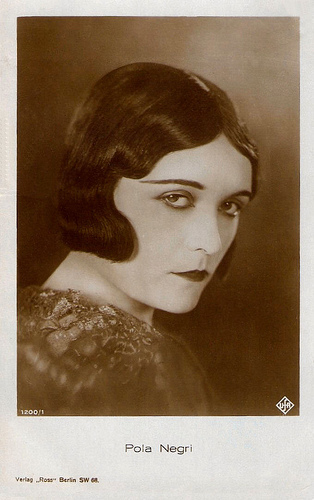
From Poland: Pola Negri . German postcard by Ross Verlag, no. 1200/1, 1927-1928. Photo: Ufa.
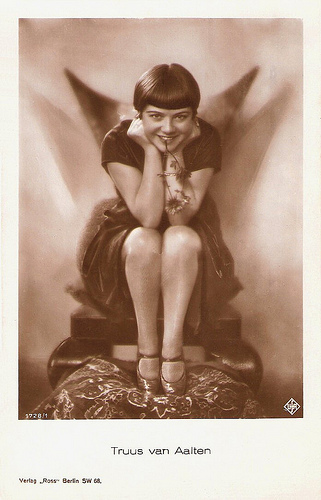
From The Netherlands: Truus van Aalten . German postcard by Ross Verlag, no. 1720/1, 1927-1928. Photo: Ufa.
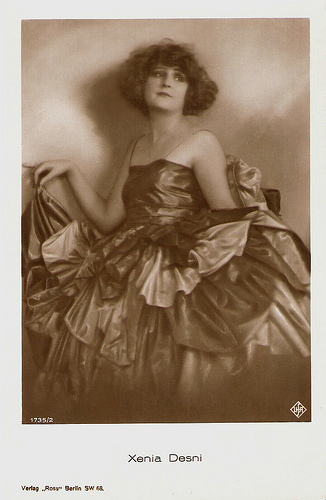
From Ukrain: Xenia Desnia . German postcard by Ross Verlag, no. 1735/2, 1927-1928. Photo: Ufa.
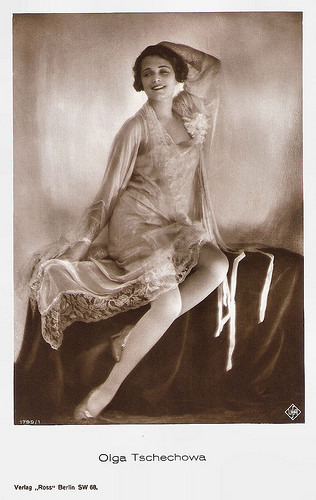
From Russia: Olga Tschechova . German postcard by Ross Verlag, no. 1799/1, 1927-1928. Photo: Ufa.
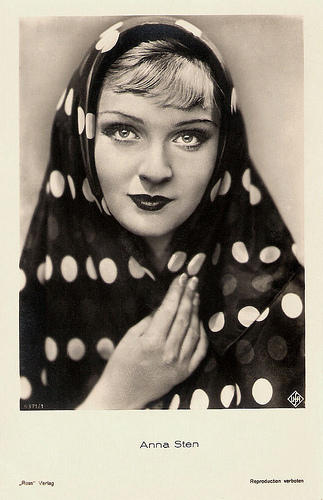
From Ukrain: Anna Sten . German postcard by Ross Verlag, no. 6371/1, 1931-1932. Photo: Ufa.
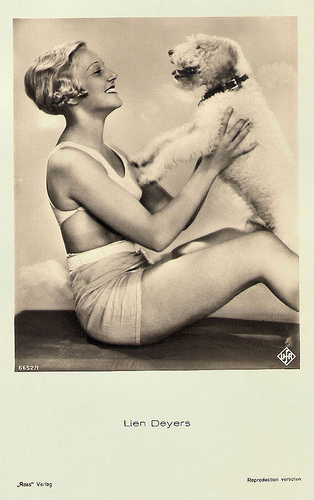
From The Netherlands: Lien Deyers . German postcard by Ross Verlag, no. 6552/1, 1931-1932. Photo: Ufa. Collection: Geoffrey Donaldson Instituut.
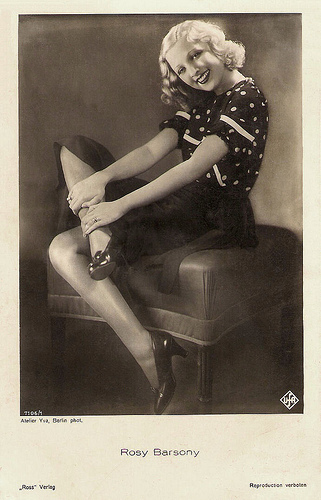
From Hungary: Rose Barsony . German postcard by Ross Verlag, no. 7106/1, 1932-1933. Photo: Atelier Yva, Berlin / Ufa.
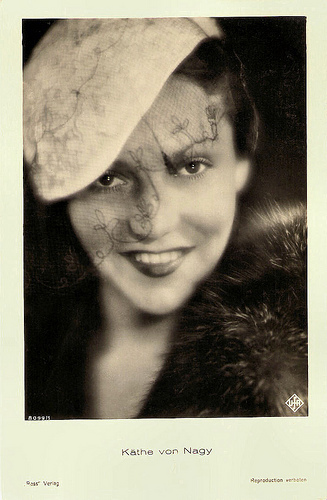
From Hungary: Käthe von Nagy . German postcard by Ross Verlag, no. 8099/1, 1933-1934. Photo: Ufa.
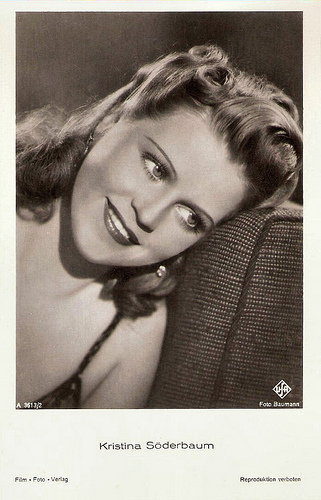
From Sweden: Kristina Söderbaum . German postcard by Film-Foto-Verlag, no. A 3613/2, 1941-1944. Photo: Baumann / Ufa. Collection: Geoffrey Donaldson Instituut.
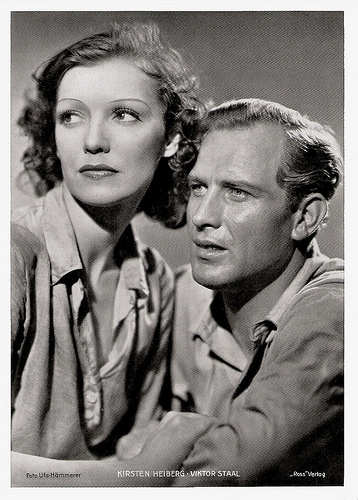
From Norway: Kirsten Heiberg . Big card by Ross Verlag. Photo: Hämmerer / Ufa. Publicity still for Frauen für Golden Hill/Women for Golden Hill (Erich Waschneck, 1938) with Viktor Staal .
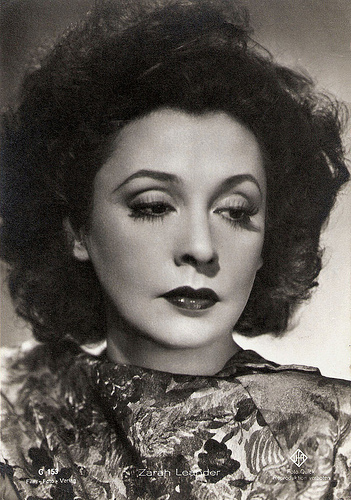
From Sweden: Zarah Leander . German postcard by Film-Foto-Verlag, no. G 153, 1941-1944. Photo: Foto Quick / Ufa.
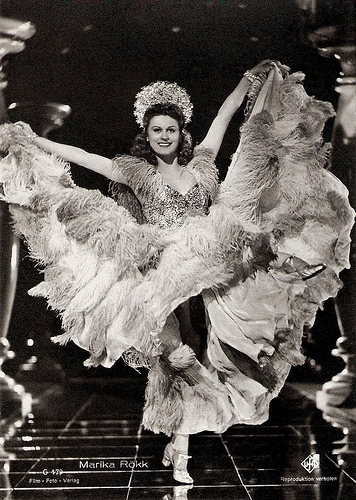
From Hungary: Marika Rökk . German postcard by Film-Foto-Verlag, no. G 179, 1941-1944. Photo: Ufa.
This is a post for Postcard Friendship Friday, hosted by Beth at the The Best Hearts are Crunchy. You can visit her by clicking on the button below.


From Poland: Pola Negri . German postcard by Ross Verlag, no. 1200/1, 1927-1928. Photo: Ufa.

From The Netherlands: Truus van Aalten . German postcard by Ross Verlag, no. 1720/1, 1927-1928. Photo: Ufa.

From Ukrain: Xenia Desnia . German postcard by Ross Verlag, no. 1735/2, 1927-1928. Photo: Ufa.

From Russia: Olga Tschechova . German postcard by Ross Verlag, no. 1799/1, 1927-1928. Photo: Ufa.

From Ukrain: Anna Sten . German postcard by Ross Verlag, no. 6371/1, 1931-1932. Photo: Ufa.

From The Netherlands: Lien Deyers . German postcard by Ross Verlag, no. 6552/1, 1931-1932. Photo: Ufa. Collection: Geoffrey Donaldson Instituut.

From Hungary: Rose Barsony . German postcard by Ross Verlag, no. 7106/1, 1932-1933. Photo: Atelier Yva, Berlin / Ufa.

From Hungary: Käthe von Nagy . German postcard by Ross Verlag, no. 8099/1, 1933-1934. Photo: Ufa.

From Sweden: Kristina Söderbaum . German postcard by Film-Foto-Verlag, no. A 3613/2, 1941-1944. Photo: Baumann / Ufa. Collection: Geoffrey Donaldson Instituut.

From Norway: Kirsten Heiberg . Big card by Ross Verlag. Photo: Hämmerer / Ufa. Publicity still for Frauen für Golden Hill/Women for Golden Hill (Erich Waschneck, 1938) with Viktor Staal .

From Sweden: Zarah Leander . German postcard by Film-Foto-Verlag, no. G 153, 1941-1944. Photo: Foto Quick / Ufa.

From Hungary: Marika Rökk . German postcard by Film-Foto-Verlag, no. G 179, 1941-1944. Photo: Ufa.
This is a post for Postcard Friendship Friday, hosted by Beth at the The Best Hearts are Crunchy. You can visit her by clicking on the button below.

Published on January 14, 2016 22:00
January 13, 2016
Imported from the USA: Mamie van Doren
Voluptuous American actress Mamie Van Doren (1931) was a sex symbol of the 1950s and 1960s. Van Doren starred in several exploitation films such as Untamed Youth (1957), loaded with rock 'n' roll and juvenile delinquency. Her onscreen wardrobe usually consisted of tight sweaters, torpedo bras, skin-tight capri pants, and daring swimsuits. Mamie and her colleague blond bombshells Marilyn Monroe and Jayne Mansfield were known as 'The Three M's.' In the 1960s, she appeared in some European films.
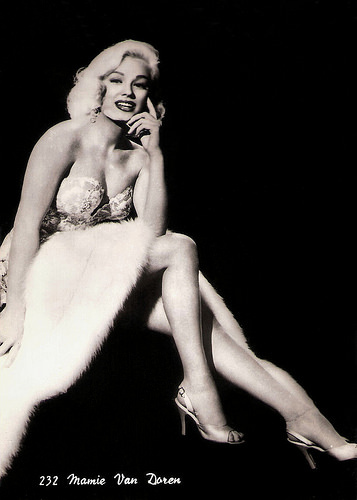
Italian postcard in the series Divi del Cinema by Vetta Traldi, Milano, no 232.
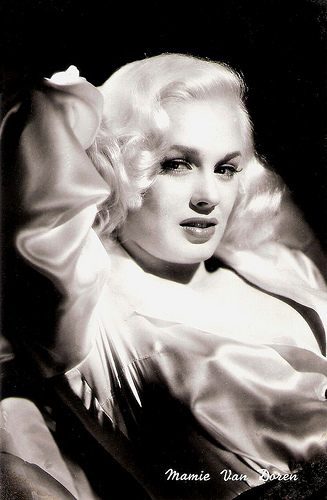
Italian postcard by Bromofoto, Milano (Milan). Sent by mail in the Netherlands in 1958.
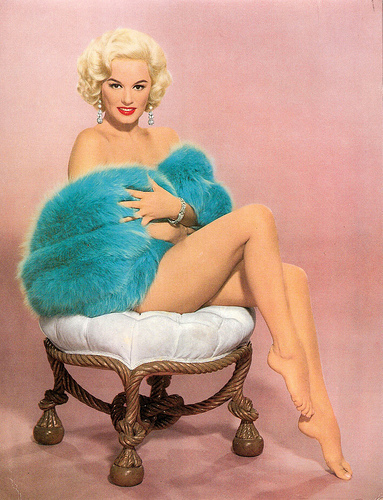
Big German card by ISV, no. PX 3.
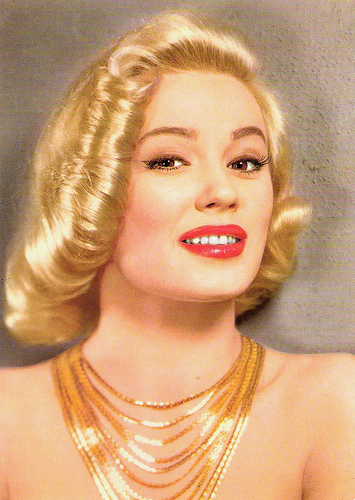
Italian postcard by Rotalfoto, Milano, no. 39.
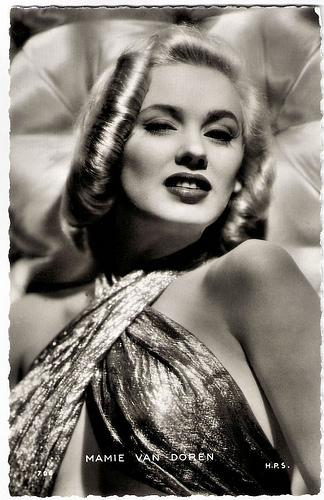
French postcard by P.I., Paris, no. 706, offered by Les Carbones Korès 'Carboplane'. Photo: H.P.S.
Condemned by the Catholic Legion of Decency
Mamie Van Doren was born Joan Lucille Olander in Rowena, South Dakota, in 1931. She was the daughter of Warner Carl Olander and Lucille Harriet Bennett. In 1942 the family moved to Los Angeles.
In early 1946, Van Doren began working as an usher at the Pantages Theatre in Hollywood. The following year, she had a bit part on an early television show. She also sang with Ted Fio Rito's band and entered several beauty contests. She was married for a brief time at seventeen when Van Doren and her first husband, Jack Newman, eloped to Santa Barbara. The marriage was dissolved quickly, upon her discovery of his abusive nature.
In the summer of 1949, at age 18, she won the titles Miss Eight Ball and Miss Palm Springs. Van Doren was discovered by producer Howard Hughes the night she was crowned Miss Palm Springs. The pair dated for five years. Hughes provided her with a bit role in Jet Pilot at RKO Radio Pictures. Her line of dialogue inconsisted of one word, "Look!".
The following year, 1951, she posed for famous pin-up girl artist Alberto Vargas, the painter of the glamorous Vargas Girls. His painting of Van Doren was on the July 1951 cover of Esquire magazine. Van Doren did a few more bit parts in RKO films, including His Kind of Woman (John Farrow, 1951) starring Robert Mitchum and Jane Russell.
Van Doren then began working on the stage. She was a showgirl in New York in Monte Proser's nightclub version of Billion Dollar Baby. Songwriter Jimmy McHugh discovered her for his musicals, then decided she was too good for the chorus line and should have dramatic training. She studied with Ben Bard and Bliss-Hayden. While appearing in the role of Marie in a showcase production of Come Back, Little Sheba, Van Doren was seen by Phil Benjamin, a casting director at Universal International.
In 1953, Van Doren signed a contract with Universal Studios. They had big plans for her, hoping she would bring the same kind of success that 20th Century Fox had with Marilyn Monroe. Van Doren, whose signing day coincided with the inauguration of President Eisenhower, was given the first name Mamie for Ike's wife, Mamie Eisenhower. Universal first cast Van Doren in a minor role as a singer in Forbidden (Rudolph Maté, 1953), starring Tony Curtis.
Interested in Van Doren's allure, Universal then cast her again opposite Curtis in The All American (Jesse Hibbs, 1953), playing her first major role as Susie Ward, a wayward girl who is the man-trap at a campus beer joint. In Yankee Pasha (Joseph Pevney, 1954), starring Jeff Chandler and Rhonda Fleming, she played a slave girl, Lilith. In 1955, she had a supporting role in the musical Ain't Misbehavin' (Edward Buzzell, 1955) and starred in the crime-drama, Running Wild (Abner Biberman, 1955).
Soon thereafter, Van Doren turned down a Broadway role in the play Will Success Spoil Rock Hunter?, and was replaced by newcomer Jayne Mansfield. In 1956, Van Doren appeared in the Western Star in the Dust (Charles F. Haas, 1956). Though Van Doren garnered prominent billing alongside John Agar and Richard Boone, she appears rather briefly, as the daughter of a ranch owner. By this time, Van Doren had grown tired of Universal, which was only casting her in non-breakthrough roles. Therefore, Van Doren began accepting bigger roles in better movies from other studios, such as Teacher's Pet (George Seaton, 1958) with Doris Day and Clark Gable.
She appeared in some of the first movies to feature rock 'n' roll music, such as Untamed Youth (Howard W. Koch, 1957). Hal Erickson at AllMovie : "Delivering a superb performance under the circumstances, Russ Tamblyn heads the cast as 'typical' high schooler Tony Baker. Usually seen in the company of his voluptuous "aunt" Gwen Dulaine (the truly impressive Mamie Van Doren), Tony convinces one and all that he's looking for kicks of the controlled-substance kind. In truth, however, our hero is really an undercover narcotics agent named Mike Wilson, bound and determined to smash the operation of drug lord Mr. A. (Jackie Coogan). The once-in-a-lifetime cast includes such worthies as John Drew Barrymore (Drew Barrymore's daddy), Ray Anthony (then married to Mamie Van Doren), Charles Chaplin Jr., Michael Landon, and Jerry Lee Lewis as 'himself'." The film was originally condemned by the Catholic Legion of Decency, but that only served to enhance the curiosity factor, resulting in it being a big moneymaker for the studio.
Van Doren became identified with this rebellious style, and made some rock records. She went to star in several bad girl movies that later became cult films. These include Born Reckless (Howard W. Koch, 1958), High School Confidential (Jack Arnold, 1958), and The Beat Generation (Charles F. Haas, 1959). After Universal Studios chose not to renew her contract in 1959, Van Doren was now a free agent and had to struggle to find work.
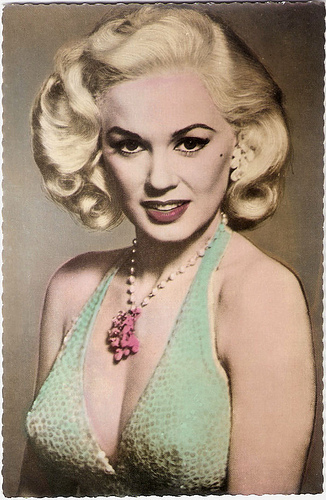
Yugoslavian postcard by Ifis-glas, Smederevo.
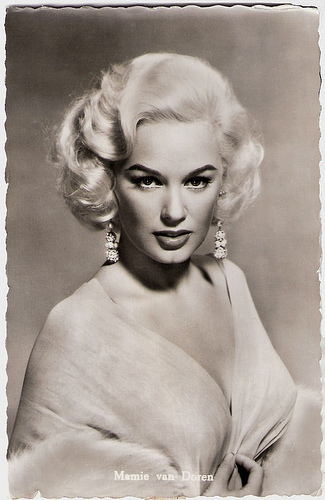
Dutch postcard by 'Emdeeha' de Hond, Oosterbeek, no. 15. Photo: MGM.
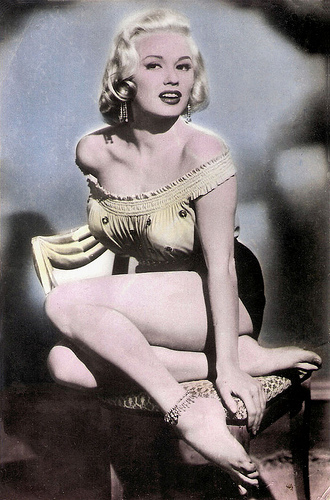
Yugoslavian postcard by Studio Sombor.
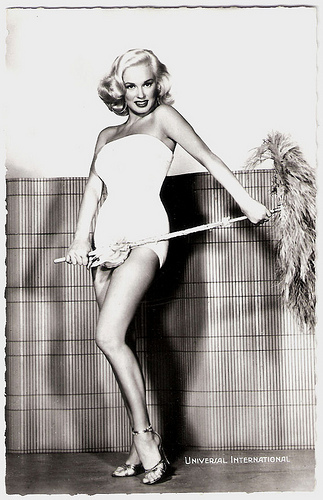
French postcard by Editions du Globe, no. 475. Photo: Universal International / International Press.
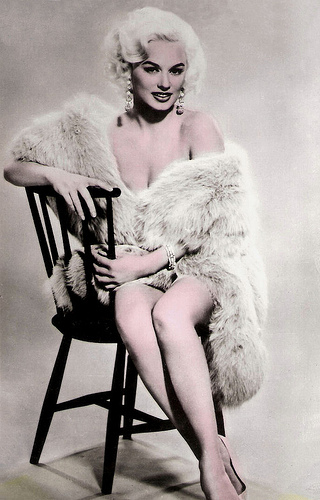
Yugoslavian postcard.
Hip-hugging skin-tight pants and seashell brassieres
Mamie Van Doren became known for her provocative roles. She was in prison for Girls Town (Charles F. Haas, 1959), which provoked censors with a shower scene where audiences could see Van Doren's naked back. As Eve in The Private Lives of Adam and Eve (Mickey Rooney, Albert Zugsmith, 1960) she wore only fig leaves, and in other films, like Vice Raid (Edward L. Cahn, 1960) audiences were clued in as to the nature of the films from the titles. Many of these productions were low-budget B-movies which sometimes gained a cult following for their high camp value. An example is Sex Kittens Go to College (Albert Zugsmith, 1960), which co-starred Tuesday Weld and Mijanou Bardot - Brigitte's sister.
Mamie also appeared in foreign productions, such as the Italian crime comedy Le bellissime gambe di Sabrina/The Beautiful Legs of Sabrina (Camillo Mastrocinque, 1959) with Antonio Cifariello, and the Argentine film Una americana en Buenos Aires/The Blonde from Buenos Aires (George Cahan, 1961) with Jean-Pierre Aumont . Van Doren took some time off from her career and came back to the screen in 1964. That year she played in the German Western musical Freddy und das Lied der Prärie/In the Wild West (Sobey Martin, 1964), starring Freddy Quinn and Rik Battaglia .
Tommy Noonan convinced Van Doren to appear as a neurotic striptease artist in 3 Nuts in Search of a Bolt (Tommy Noonan, 1964). Van Doren had turned down Noonan's previous offer to star in Promises! Promises!, in which she would have to do nude scenes. She was replaced by Jayne Mansfield . In 3 Nuts in Search of a Bolt, Mamie did a beer-bath scene, but is not seen nude. She posed for Playboy to promote the film.
Van Doren next appeared in The Las Vegas Hillbillys (Arthur C. Pierce, 1966) which co-starred Jayne Mansfield . It was the only time two of 'The Three M's' appeared together in a film. A sequel was titled Hillbillys in a Haunted House, but Van Doren turned this role down, and was replaced by Joi Lansing. She appeared in You've Got to Be Smart (Ellis Kadison, 1967), and the Sci-Fi film, Voyage to the Planet of Prehistoric Women (1968), directed by the young Peter Bogdanovich (as Derek Thomas). In this film astronauts land on Venus and encounter dangerous creatures and meet sexy Venusian women who like to sun-bathe in hip-hugging skin-tight pants and seashell brassieres.
In 1968, she was offered the role of a murder victim in the independent horror film The Ice House as a replacement for Mansfield, who died the previous year. She turned the offer down, however, and was replaced by Sabrina . During the Vietnam War, she did tours for U.S. troops in Vietnam for three months in 1968, and again in 1970. Van Doren also developed a nightclub act and did live theatre. She performed in stage productions of Gentlemen Prefer Blondes and Dames at Sea at the Drury Lane Theater, Chicago, and appeared in Will Success Spoil Rock Hunter? and The Tender Trap at the Arlington Park Theater.
After a supporting role in the Western The Arizona Kid (Luciano B. Carlos, 1970), Mamie Van Doren disappeared from films. In the 1970s, she performed a nightclub act in Las Vegas. Hal Erickson at AllMovie : "Van Doren continued popping up at important Hollywood social functions and awards presentations, as zaftig and exhibitionist as ever, much to the delight of her ever-growing fan club. In 1987 Mamie Van Doren wrote her memoirs, Playing the Field, in which she claims she slept with practically every male star in the entertainment industry."
Playing the Field (1987) brought much new attention and proved to be her biggest media splash in over 25 years. Since the book's publication she has often been interviewed and profiled and has occasionally returned to acting. Van Doren's guest appearances on television include Fantasy Island, Burke's Law, Vega$, and L.A. Law. Van Doren's last film appearance was a cameo role in the comedy Slackers (Dewey Nicks, 2002).
Van Doren has been married five times. Her first marriage was to sportswear manufacturer Jack Newman whom she married and divorced in 1950. Her second marriage was to bandleader, composer and actor Ray Anthony whom she married in 1955. They had one son, Perry Ray Anthony (1956). The couple later divorced in 1961. When Van Doren's early 1960s, highly publicised, on-again off-again engagement to baseball player Bo Belinsky ended in 1964, she married baseball player Lee Meyers in 1966. They were divorced in 1967. Her fourth marriage was to businessman Ross McClintock in 1972. They met while working on President Nixon's reelection campaign; the marriage was annulled in 1973. Since 1979 she has been married to Thomas Dixon, an actor and dentist.
Trailer Untamed Youth (Howard W. Koch, 1957). Source: Captainbijou.com (YouTube).
Trailer for Vice Raid (Edward L. Cahn, 1960). Source: Captainbijou.com (YouTube).
Trailer for Sex Kittens Go to College (Albert Zugsmith, 1960). Source: Horrormovieshows (YouTube).
Trailer for The Navy vs. the Night Monsters (1966). Source: Sleaze-o-rama (YouTube).
Mamie sings Oobala Baby and Go Go Calypso in Untamed Youth (Howard W. Koch, 1957). Source: SuperCanopus (YouTube).
Sources: Hal Erickson (AllMovie). Wikipedia and .

Italian postcard in the series Divi del Cinema by Vetta Traldi, Milano, no 232.

Italian postcard by Bromofoto, Milano (Milan). Sent by mail in the Netherlands in 1958.

Big German card by ISV, no. PX 3.

Italian postcard by Rotalfoto, Milano, no. 39.

French postcard by P.I., Paris, no. 706, offered by Les Carbones Korès 'Carboplane'. Photo: H.P.S.
Condemned by the Catholic Legion of Decency
Mamie Van Doren was born Joan Lucille Olander in Rowena, South Dakota, in 1931. She was the daughter of Warner Carl Olander and Lucille Harriet Bennett. In 1942 the family moved to Los Angeles.
In early 1946, Van Doren began working as an usher at the Pantages Theatre in Hollywood. The following year, she had a bit part on an early television show. She also sang with Ted Fio Rito's band and entered several beauty contests. She was married for a brief time at seventeen when Van Doren and her first husband, Jack Newman, eloped to Santa Barbara. The marriage was dissolved quickly, upon her discovery of his abusive nature.
In the summer of 1949, at age 18, she won the titles Miss Eight Ball and Miss Palm Springs. Van Doren was discovered by producer Howard Hughes the night she was crowned Miss Palm Springs. The pair dated for five years. Hughes provided her with a bit role in Jet Pilot at RKO Radio Pictures. Her line of dialogue inconsisted of one word, "Look!".
The following year, 1951, she posed for famous pin-up girl artist Alberto Vargas, the painter of the glamorous Vargas Girls. His painting of Van Doren was on the July 1951 cover of Esquire magazine. Van Doren did a few more bit parts in RKO films, including His Kind of Woman (John Farrow, 1951) starring Robert Mitchum and Jane Russell.
Van Doren then began working on the stage. She was a showgirl in New York in Monte Proser's nightclub version of Billion Dollar Baby. Songwriter Jimmy McHugh discovered her for his musicals, then decided she was too good for the chorus line and should have dramatic training. She studied with Ben Bard and Bliss-Hayden. While appearing in the role of Marie in a showcase production of Come Back, Little Sheba, Van Doren was seen by Phil Benjamin, a casting director at Universal International.
In 1953, Van Doren signed a contract with Universal Studios. They had big plans for her, hoping she would bring the same kind of success that 20th Century Fox had with Marilyn Monroe. Van Doren, whose signing day coincided with the inauguration of President Eisenhower, was given the first name Mamie for Ike's wife, Mamie Eisenhower. Universal first cast Van Doren in a minor role as a singer in Forbidden (Rudolph Maté, 1953), starring Tony Curtis.
Interested in Van Doren's allure, Universal then cast her again opposite Curtis in The All American (Jesse Hibbs, 1953), playing her first major role as Susie Ward, a wayward girl who is the man-trap at a campus beer joint. In Yankee Pasha (Joseph Pevney, 1954), starring Jeff Chandler and Rhonda Fleming, she played a slave girl, Lilith. In 1955, she had a supporting role in the musical Ain't Misbehavin' (Edward Buzzell, 1955) and starred in the crime-drama, Running Wild (Abner Biberman, 1955).
Soon thereafter, Van Doren turned down a Broadway role in the play Will Success Spoil Rock Hunter?, and was replaced by newcomer Jayne Mansfield. In 1956, Van Doren appeared in the Western Star in the Dust (Charles F. Haas, 1956). Though Van Doren garnered prominent billing alongside John Agar and Richard Boone, she appears rather briefly, as the daughter of a ranch owner. By this time, Van Doren had grown tired of Universal, which was only casting her in non-breakthrough roles. Therefore, Van Doren began accepting bigger roles in better movies from other studios, such as Teacher's Pet (George Seaton, 1958) with Doris Day and Clark Gable.
She appeared in some of the first movies to feature rock 'n' roll music, such as Untamed Youth (Howard W. Koch, 1957). Hal Erickson at AllMovie : "Delivering a superb performance under the circumstances, Russ Tamblyn heads the cast as 'typical' high schooler Tony Baker. Usually seen in the company of his voluptuous "aunt" Gwen Dulaine (the truly impressive Mamie Van Doren), Tony convinces one and all that he's looking for kicks of the controlled-substance kind. In truth, however, our hero is really an undercover narcotics agent named Mike Wilson, bound and determined to smash the operation of drug lord Mr. A. (Jackie Coogan). The once-in-a-lifetime cast includes such worthies as John Drew Barrymore (Drew Barrymore's daddy), Ray Anthony (then married to Mamie Van Doren), Charles Chaplin Jr., Michael Landon, and Jerry Lee Lewis as 'himself'." The film was originally condemned by the Catholic Legion of Decency, but that only served to enhance the curiosity factor, resulting in it being a big moneymaker for the studio.
Van Doren became identified with this rebellious style, and made some rock records. She went to star in several bad girl movies that later became cult films. These include Born Reckless (Howard W. Koch, 1958), High School Confidential (Jack Arnold, 1958), and The Beat Generation (Charles F. Haas, 1959). After Universal Studios chose not to renew her contract in 1959, Van Doren was now a free agent and had to struggle to find work.

Yugoslavian postcard by Ifis-glas, Smederevo.

Dutch postcard by 'Emdeeha' de Hond, Oosterbeek, no. 15. Photo: MGM.

Yugoslavian postcard by Studio Sombor.

French postcard by Editions du Globe, no. 475. Photo: Universal International / International Press.

Yugoslavian postcard.
Hip-hugging skin-tight pants and seashell brassieres
Mamie Van Doren became known for her provocative roles. She was in prison for Girls Town (Charles F. Haas, 1959), which provoked censors with a shower scene where audiences could see Van Doren's naked back. As Eve in The Private Lives of Adam and Eve (Mickey Rooney, Albert Zugsmith, 1960) she wore only fig leaves, and in other films, like Vice Raid (Edward L. Cahn, 1960) audiences were clued in as to the nature of the films from the titles. Many of these productions were low-budget B-movies which sometimes gained a cult following for their high camp value. An example is Sex Kittens Go to College (Albert Zugsmith, 1960), which co-starred Tuesday Weld and Mijanou Bardot - Brigitte's sister.
Mamie also appeared in foreign productions, such as the Italian crime comedy Le bellissime gambe di Sabrina/The Beautiful Legs of Sabrina (Camillo Mastrocinque, 1959) with Antonio Cifariello, and the Argentine film Una americana en Buenos Aires/The Blonde from Buenos Aires (George Cahan, 1961) with Jean-Pierre Aumont . Van Doren took some time off from her career and came back to the screen in 1964. That year she played in the German Western musical Freddy und das Lied der Prärie/In the Wild West (Sobey Martin, 1964), starring Freddy Quinn and Rik Battaglia .
Tommy Noonan convinced Van Doren to appear as a neurotic striptease artist in 3 Nuts in Search of a Bolt (Tommy Noonan, 1964). Van Doren had turned down Noonan's previous offer to star in Promises! Promises!, in which she would have to do nude scenes. She was replaced by Jayne Mansfield . In 3 Nuts in Search of a Bolt, Mamie did a beer-bath scene, but is not seen nude. She posed for Playboy to promote the film.
Van Doren next appeared in The Las Vegas Hillbillys (Arthur C. Pierce, 1966) which co-starred Jayne Mansfield . It was the only time two of 'The Three M's' appeared together in a film. A sequel was titled Hillbillys in a Haunted House, but Van Doren turned this role down, and was replaced by Joi Lansing. She appeared in You've Got to Be Smart (Ellis Kadison, 1967), and the Sci-Fi film, Voyage to the Planet of Prehistoric Women (1968), directed by the young Peter Bogdanovich (as Derek Thomas). In this film astronauts land on Venus and encounter dangerous creatures and meet sexy Venusian women who like to sun-bathe in hip-hugging skin-tight pants and seashell brassieres.
In 1968, she was offered the role of a murder victim in the independent horror film The Ice House as a replacement for Mansfield, who died the previous year. She turned the offer down, however, and was replaced by Sabrina . During the Vietnam War, she did tours for U.S. troops in Vietnam for three months in 1968, and again in 1970. Van Doren also developed a nightclub act and did live theatre. She performed in stage productions of Gentlemen Prefer Blondes and Dames at Sea at the Drury Lane Theater, Chicago, and appeared in Will Success Spoil Rock Hunter? and The Tender Trap at the Arlington Park Theater.
After a supporting role in the Western The Arizona Kid (Luciano B. Carlos, 1970), Mamie Van Doren disappeared from films. In the 1970s, she performed a nightclub act in Las Vegas. Hal Erickson at AllMovie : "Van Doren continued popping up at important Hollywood social functions and awards presentations, as zaftig and exhibitionist as ever, much to the delight of her ever-growing fan club. In 1987 Mamie Van Doren wrote her memoirs, Playing the Field, in which she claims she slept with practically every male star in the entertainment industry."
Playing the Field (1987) brought much new attention and proved to be her biggest media splash in over 25 years. Since the book's publication she has often been interviewed and profiled and has occasionally returned to acting. Van Doren's guest appearances on television include Fantasy Island, Burke's Law, Vega$, and L.A. Law. Van Doren's last film appearance was a cameo role in the comedy Slackers (Dewey Nicks, 2002).
Van Doren has been married five times. Her first marriage was to sportswear manufacturer Jack Newman whom she married and divorced in 1950. Her second marriage was to bandleader, composer and actor Ray Anthony whom she married in 1955. They had one son, Perry Ray Anthony (1956). The couple later divorced in 1961. When Van Doren's early 1960s, highly publicised, on-again off-again engagement to baseball player Bo Belinsky ended in 1964, she married baseball player Lee Meyers in 1966. They were divorced in 1967. Her fourth marriage was to businessman Ross McClintock in 1972. They met while working on President Nixon's reelection campaign; the marriage was annulled in 1973. Since 1979 she has been married to Thomas Dixon, an actor and dentist.
Trailer Untamed Youth (Howard W. Koch, 1957). Source: Captainbijou.com (YouTube).
Trailer for Vice Raid (Edward L. Cahn, 1960). Source: Captainbijou.com (YouTube).
Trailer for Sex Kittens Go to College (Albert Zugsmith, 1960). Source: Horrormovieshows (YouTube).
Trailer for The Navy vs. the Night Monsters (1966). Source: Sleaze-o-rama (YouTube).
Mamie sings Oobala Baby and Go Go Calypso in Untamed Youth (Howard W. Koch, 1957). Source: SuperCanopus (YouTube).
Sources: Hal Erickson (AllMovie). Wikipedia and .
Published on January 13, 2016 22:00
Paul van Yperen's Blog
- Paul van Yperen's profile
- 13 followers
Paul van Yperen isn't a Goodreads Author
(yet),
but they
do have a blog,
so here are some recent posts imported from
their feed.



